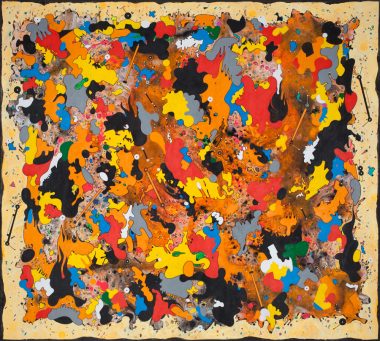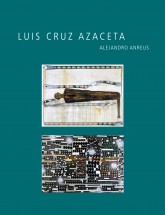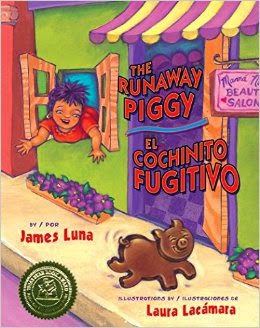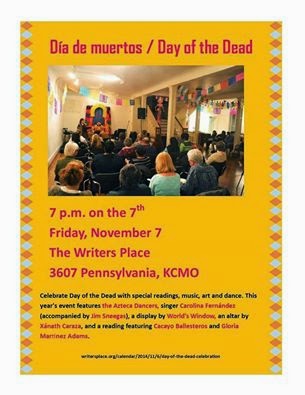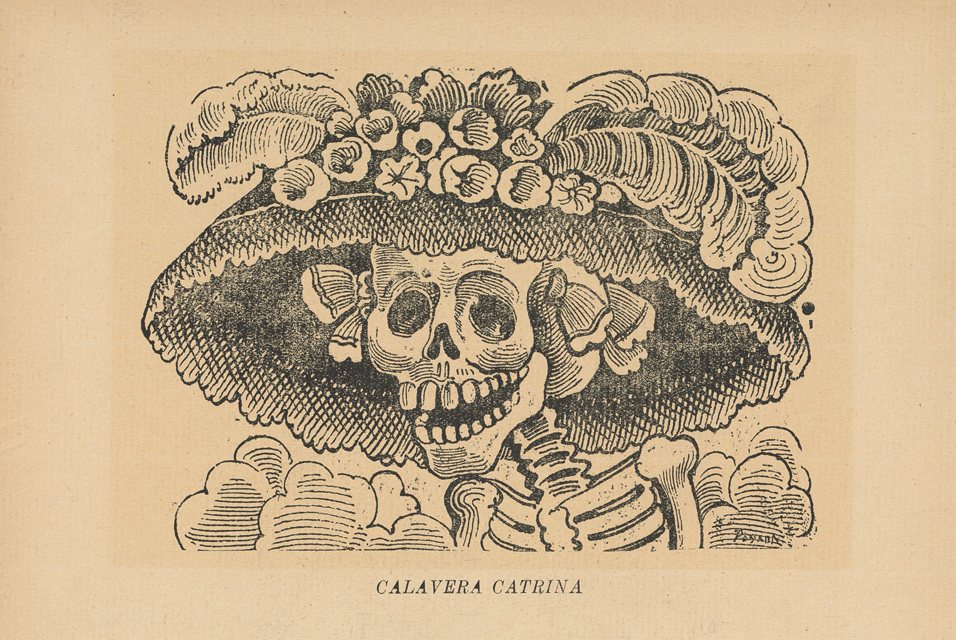Viewing Blog: La Bloga, Most Recent at Top
Results 51 - 75 of 2,429

Chicana Chicano Literature, Chicana Chicano Writers, Chicana Chicano Fiction, Children's Literature, News, Views, Reviews
Statistics for La Bloga
Number of Readers that added this blog to their MyJacketFlap: 11
Blog: La Bloga (Login to Add to MyJacketFlap)
JacketFlap tags: authors, picture books, Add a tag
Blog: La Bloga (Login to Add to MyJacketFlap)
JacketFlap tags: 43, ayotzinapa, poetry, poems, Floricanto Movement, Add a tag
Michael Sedano
When I was in the Army I decided I would kill anyone who faced me in war, but I found myself on a Korean mountaintop and didn't face the truth. My friend Mario Trillo, who was getting shot-up in Vietnam the same time I was in Korea, wrote the other day that each successive kill lightened the load on his conscience. Killing another person, the thought of it even, weighs on a person.
So what is it that allows people to kill forty-three fellow people in an act of pitiless deliberateness? Who gives the orders? And when mass grave after mass grave after mass grave turned out to be not the 43, hope for the missing teaching students dimmed:
43 estudiantes de la Escuela Normal Rural Raúl Isidro Burgos, de Ayotzinapa, Tixtla, en el Estado de Guerrero, México, están desaparecidos desde el 26 de septiembre de 2014. Vivos se llevaron. Vivos los queremos.
The students murdered in Iguala were locals. The narcos were locals. The cops were locals. They saw each other on the street. They'd looked into each other's eyes before. Some grew up together.
The imperial couple were cosmopolitan, de la primera clase. The students, the professor, the campesino--the 43--were los de abajo. They would have been teachers, the victims. They could have been teachers, the gunmen. Two roads diverged not long before Iguala.
Shoulda. Woulda. Coulda. I grieve. You grieve. We grieve. Today, 13 poets grieve the 43. !Faltamos 43!
On-line Floricanto: 13 for the 43
Iris De Anda, Marcela Ibarra Mateos, Betty Sánchez, Sonia Gutiérrez, Xánath Caraza, Sharon Elliott, Viva Flores, Daniel Vidal Soto, Patrick Fontes, Jan G. Otterstrom, Andrea Mauk, Nephtalí De León, Carolina Torres
"Ayotzinapa: Rojo Amanecer" Por Iris De Anda
"Mamá, si desaparezco, ¿a dónde voy? / Mother, If I Disappear, Where Do I Go?" By Marcela Ibarra Mateos (Trans. Sonia Gutírrez)
"Todos Somos Ayotzinapa" Por Betty Sánchez
"Los huesos hablan / Bones Speak" By Sonia Gutiérrez
"Espuma Sangrante" Por Xánath Caraza
"Semillas de Ayotzinapa" By Sharon Elliott
"Lucecitas, para Ayotzinapa" Por Viva Flores
"A Poster Asks to Find the Missing 43" By Daniel Vidal Soto
"La Llorona Weeps Once More" By Patrick Fontes
"Hijos perdidos" Por Jan G. Otterstrom
"Mexico, My Mirror" By Andrea Mauk
"43 Howls of the Soul" By Nephtalí De León
"Nudo" Por Carolina Torres
Ayotzinapa: Rojo Amanecer
Por Iris De Anda
tápame los ojos
que ya no puedo ver
el duelo de mi país
otro rojo amancer
el gobierno es maestro de oscuridad
los estudiantes ejercen la luz
es por eso que los de arriba
dan órdenes para apagar
el fuego del pueblo
pues les ilumina
su corrupción
pero les falla su matanza
porque por cada vela que apagan
se enciendien 43 más y más y más
cuarenta y tres semillas de luz digna rabia
se estremece el mundo entero
la humanidad está de luto
y los 43 viven en su llanto
no dejes que te llenen de miedo
la justicia es tu arma
y el sol tu aliento
porque otro rojo amanecer
no podemos aguantar
sigue luchando
mi gente presente
la luz es de quien la enciende
tu voz es un altar
recordamos a los caídos
los levantamos en nuestro gritar
Ya Basta Ayotzinapa
tu sembraste un campo de ideas
ahora la cosecha despierta
ombligo de México
nace tu revancha
el gobierno no se queda impune
porque el pueblo se levanta
levantate hermano
levántate ya
tus compañeros te apoyan
desde el desierto y la montaña
cruzamos fronteras
unimos las manos
tu duelo es el mío
y tu noche la mía
marchamos con luz de dia
exigimos justicia
- Abel García Hernández
- Abelardo Vázquez Peniten
- Adán Abrajan de la Cruz
- Alexander Mora Venancio
- Antonio Santana Maestro
- Benjamín Ascencio Bautista
- Bernardo Flores Alcaraz
- Carlos Iván Ramírez Villarreal
- Carlos Lorenzo Hernández Muñoz
- César Manuel González Hernández
- Christian Alfonso Rodríguez Telumbre
- Christian Tomás Colón Garnica
- Cutberto Ortiz Ramos
- Dorian González Parral
- Emiliano Alen Gaspar de la Cruz.
- Everardo Rodríguez Bello
- Felipe Arnulfo Rosas
- Giovanni Galindes Guerrero
- Israel Caballero Sánchez
- Israel Jacinto Lugardo
- Jesús Jovany Rodríguez Tlatempa
- Jonas Trujillo González
- Jorge Álvarez Nava
- Jorge Aníbal Cruz Mendoza
- Jorge Antonio Tizapa Legideño
- Jorge Luis González Parral
- José Ángel Campos Cantor
- José Ángel Navarrete González
-José Eduardo Bartolo Tlatempa
-José Luis Luna Torres
-Jhosivani Guerrero de la Cruz
-Julio César López Patolzin
-Leonel Castro Abarca
-Luis Ángel Abarca Carrillo
-Luis Ángel Francisco Arzola
-Magdaleno Rubén Lauro Villegas
-Marcial Pablo Baranda
-Marco Antonio Gómez Molina
-Martín Getsemany Sánchez García
-Mauricio Ortega Valerio
-Miguel Ángel Hernández Martínez
-Miguel Ángel Mendoza Zacarías
-Saúl Bruno García
Iris De Anda is a writer, activist, and practitioner of the healing arts. A womyn of color of Mexican and Salvadorean descent. A native of Los Angeles she believes in the power of spoken word, poetry, storytelling, and dreams. She has been published in Mujeres de Maiz Zine, Loudmouth Zine: Cal State LA, OCCUPY SF poems from the movement, Seeds of Resistance, In the Words of Women, Twenty: In Memoriam, Revolutionary Poets Brigade Los Angeles Anthology, and online at La Bloga. She is an active contributor to Poets Responding to SB 1070. She performs at community venues and events throughout the Los Angeles area & Southern California. She hosted The Writers Underground Open Mic 2012 at Mazatlan Theatre and 100,000 Poets for Change 2012, 2013, and 2014 at the Eastside Cafe. She currently hosts The Writers Underground Open Mic every Third Thursday of the month at Eastside Cafe. Author of CODESWITCH: Fires From Mi Corazon. www.irisdeanda.com
Mamá, si desaparezco, ¿a dónde voy?
Por Marcela Ibarra Mateos
Solo sé que si desaparecieras te buscaría
entre la tierra y debajo de ella.
Tocaría en cada puerta de cada casa.
Preguntaría a todas y a cada una de las personas
que encontrara en mi camino.
Exigiría, todos y cada uno de los días,
a cada instancia obligada a buscarte
que lo hiciera hasta encontrarte.
Y querría, hijo, que no tuvieras miedo,
porque te estoy buscando. Y si no me escucharan, hijo;
la voz se me haría fuerte
y gritaría tu nombre por las calles.
Rompería vidrios y tiraría puertas para buscarte.
Incendiaría edificios para que todos supieran
cuánto te quiero y cuánto quiero que regreses.
Pintaría muros con tu nombre
y no querría que nadie te olvidara.
Buscaría a otros y a otras que también
buscan a sus hijos para que juntos
te encontráramos a ti y a ellos.
Y querría, hijo, que no tuvieras miedo,
porque muchos te buscamos.
Si no desaparecieras, hijo,
como así deseo y quiero.
Gritaría los nombres de todos aquellos
que sí han desaparecido.
Escribiría sus nombres en los muros.
Abrazaría en la distancia y en la cercanía
a todos aquellos padres y madres; hermanas
y hermanos que buscan a sus desaparecidos.
Caminaría del brazo de ellos por las calles.
Y no permitiría que sus nombres fueran olvidados.
Y querría, hijo, que todos ellos no tuvieran miedo,
porque todos los buscamos.
Mother, If I Disappear, Where Do I Go?
By Marcela Ibarra Mateos
I do not know, son.
I only know that if you would disappear
I would search between the earth and beneath her.
I would knock on every house door.
I would ask every and each person
who would cross my path.
I would demand each and everyday,
every instant obliged to search for you
until you are found.
And I would want, son, for you not to fear
because I am looking for you.
And if they would not listen to me, son;
my voice would grow strong,
and I would bellow your name through the streets.
I would break glass and tear down doors to find you.
I would burn down buildings
so everybody would know
how much I love you
and how much I want you to return.
I would paint murals with your name,
and I would not want anyone to forget you.
I would search for others who are also
looking for their children, so together
we would find you and them.
And I would want son for you to not be afraid
because we are looking for you.
If you would not have disappeared, son,
as I wish and want.
I would bellow the names of all
those who have disappeared.
I would write their names on walls.
I would embrace in closeness
and in the distance all those fathers and mothers;
sisters and brothers who are looking for their disappeared.
I would walk arm in arm with them through the streets.
And I would not allow their names to be forgotten.
And I would want, son, for all of them
not to be afraid because we all searched.
La Dra. Marcela Ibarra Mateos es profesora e investigadora de la Universidad Iberoamericana Puebla en el Departamentos de Ciencias Sociales con experiencia de investigación en migraciones transnacionales; jóvenes rurales, participación comunitaria, y migración.
Sus publicaciones y ponencias han sido presentadas en foros internacionales, nacionales y locales. Publicó el libro Entre Contextos Locales y Ciudades Globales. La configuración de circuitos migratorios Puebla-Nueva York, co-coordinado con Liliana Rivera Sánchez y que reúne textos sobre migración poblana. Recientemente publicó el libro Jóvenes, migración e identidad, como resultado de un proyecto de investigación financiado por INDESOL.
Desde sus inicios ha impulsado el trabajo de investigación articulado a iniciativas de desarrollo local. Particularmente en localidades de Puebla se ha desarrollado trabajo participativo transnacional con organizaciones de migrantes y con familiares en sus localidades de origen.
Todos Somos Ayotzinapa
Por Betty Sánchez
Mi nombre puede ser el tuyo
Yo soy Ayotzinapa
Estudiante normalista
Residente de Guerrero
Padre hijo hermano amigo
Culpable del crimen
De desear superarme
De enseñar en un aula
De defender mis derechos
Y oponerme a la injusticia
Pienso luego desaparezco
En un auto gubernamental
En una burocracia a favor
Del poderoso e influyente
En un sistema municipal
Federal y judicial corrupto
En un gobierno que vende
Impunidad al que puede pagarla
En manos de sicarios
Al servicio del mejor postor
Protesto luego desaparezco
Me encontrarás de rodillas
En el patio de la policía preventiva
En una fosa clandestina
Con el cuerpo calcinado
Brutalmente torturado
Desollado con las cuencas
De los ojos vacías
Símbolo del abismo sombrío
En que vive mi gente
Mis opresores no dan la cara
El Presidente municipal
Huye con permiso y gastos pagados
El Gobernador niega estar involucrado
El Presidente de la República
Se dirige a su pueblo
Diez días después de lo acontecido
Pronunciando un discurso
Con cara de aflicción
Y balbuceando promesas endebles
El silencio ya no es una opción
No soy un caso aislado
Soy un crimen de estado
Victima del terror blanco
El reflejo de una sociedad
Donde la muerte violenta
Es un asunto cotidiano
Noticia internacional
Evento del momento
Como lo fue Tlatelolco y Acteal
No somos los primeros
Pero queremos ser los últimos
Ahora somos 43 desaparecidos
Antes de nosotros
Decenas cientos miles
Todos somos Ayotzinapa
Su lucha y su dolor son los nuestros
Únete a mi grito de indignación
Y solidaridad
¡VIVOS SE LOS LLEVARON
VIVOS LOS QUEREMOS!
Betty Sánchez
En respuesta a los acontecimientos
ocurridos el 26 de Septiembre del 2014
En Iguala Guerrero
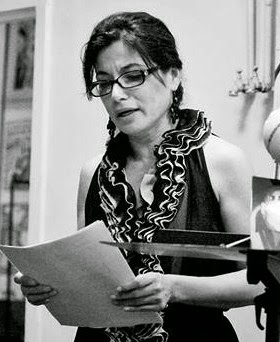 | ||
| Photo by Andres Alvarez |
Los huesos hablan
Por Sonia Gutiérrez
“Ayotzinapa: río de las calabacitas”
Los perros se comportaban como si fuera el último hueso. Pero los dueños sabían que había toneladas
de huesos almacenados en sus casas blancas, en Los Pinos, y en los palacios de gobierno. Esos patrimonios
achicaban las casitas de Ayotzinapa.
Pero los huesos no eran mudos;
hablaban. Los huesos se asomaban por los cimientos, y por eso los dueños
mandaron crear jardines botánicos para apaciguar su conciencia
y distraer a sus invitados importantísimos.
Quinientos años después,
debajo de la avaricia y del odio continuo
contra nosotros mismos,
los dueños nos dejan
máscaras rojas sin piel y con los ojos picados.
Y desde el río de las calabacitas,
los huesos se apoderaron
del sentimiento de la nación
y lo encendieron.
Pisamos fuerte por nuestros
hijos e hijas con y sin huaraches,
con tenis o zapatos,
con sandalias o botas, este suelo sagrado que nuestros antepasados caminaron,
dejando atrás el miedo haciendo temblar a los domadores
que olfatean el dinero,
el miedo y se arman
hasta los dientes.
Está claro;
los huesos sí hablan:
ustedes, los cuarenta y tres
valientes, sembraron semillas sin miedo—
existe el sueño mexicano
digno de cultivar.
Bones Speak
By Sonia Gutiérrez
“Ayotzinapa: river of little squash”
The dogs behaved as if it were the last bone. But the owners knew there were tons
of stored bones
in their white houses, at Los Pinos, in government
palaces. Those patrimonies dwarfed the little houses
of Ayotzinapa.
But the bones were not mute;
they talked. Bones peered through the foundations, and for this reason the owners
created botanical gardens to appease their conscience
and distract their very important visitors.
Five-hundred years,
underneath continues greed and hate
against ourselves,
the owners leave us
skinned red masks with minced eyes,
And from the river of little squash,
the bones took over
the sentiment of the nation
and lit it.
We step firmly for our
sons and daughters with orwithout huaraches,
with tennis shoes or shoes,
with sandals or boots,
this sacred ground
our ancestors walked,
leaving behind fear,
making the tamers,
who sniff money,
fear and arm themselves
to the teeth, tremble.
It is clear
bones do speak:
you, the valiant forty-three,
planted fearless seeds—
the Mexican dream exists
worthy of cultivating.
Sonia Gutiérrez is the daughter of two Michoacanos. She teaches English Composition and Critical Thinking and Writing at Palomar College. La Bloga is home to her Poets Responding SB 1070 poems, including “Best Poems 2011” and “Best Poems 2012.” Her vignettes have appeared in AlternaCtive PublicaCtions, Mujeres de Maíz, City Works Literary Journal, and Huizache. Her bilingual poetry collection, Spider Woman/La Mujer Araña (Olmeca Press, 2013), is her debut publication. Kissing Dreams from a Distance, a novel, is under editorial review. To learn more about Sonia, visit SoniaGutierrez.com.
Espuma Sangrante
Por Xánath Caraza
Para los 43 estudiantes de Ayotzinapa
Este mar que lame el arena
Olas hambrientas
Testigos sonoros
Luna de agua con ojos quietos
Inmóviles palmeras mudas frente a mí
Caminan los rayos del amanecer en las calles
Marchan ante el contenido rugido del mar
Aves migratorias en el horizonte
Con ellas vuelo
Arena salmón lamida por la espuma sangrante
Mientras cuarenta y tres niños perdidos
Gritan en tus líquidas rojas entrañas
Aullidos sordos, aullidos sordos
En este mar estático que ruge
Ruge mar, ruge, ruge sus nombres
Para la eternidad
By Xánath Caraza
For the 43 missing students from Ayotzinapa
The sea licks the sand
Hungry waves
Resounding witnesses
Moon of water with quiet eyes
Mute, immobile palm trees before me
Dawn sunrays walk through the streets
They march before the restrained roar of the sea
Migratory birds on the horizon
I fly with them
Salmon sand licked by bleeding foam
While forty-three lost children
Howl in your liquid red entrails
Silent screams, silent screams
In this static sea that roars
Roar, sea; roar, sea. Roar their names
For eternity
Xánath Caraza’s bilingual poetry and short story collections are Sílabas de viento/Syllables of Wind (2014), Noche de Colibríes: Ekphrastic Poems (2014), Lo que trae la marea/What the Tide Brings (2013), Conjuro (2012), and Corazón Pintado: Ekphrastic Poems (2012). She writes the column, “US Latino Poets en español”. Caraza is a writer for La Bloga and for Revista Zona de Ocio, and teaches at the University of Missouri-Kansas City (UMKC). She is an advisory circle member of the Con Tinta literary organization.
Semillas de Ayotzinapa
By Sharon Elliott
I hoped
I could construct a barrier
between us
like surgical gauze
or a
blanket
made of fir needles
from the forest floor
to keep the horror
at bay
pero a veces esperanza no sirve
instead
a dream
came gently
on a warm south wind
to a room with whitewashed walls
worn wooden floors
for dancing
llena de estudiantes
gozando la vida
in one corner
an argument
loud voices
arms gesticulating wildly
hands raised in clenched fists
above heads
sure of themselves
como compañeros
sure that even if
agreement was not reached
the truth would be told
in another corner
a muchacho with hands soft
tender
touches the face
of his beloved
yearning
she receives his caricias
con una sonrisa
and a delicate sigh
at a long scrubbed table
a portly guy
with a laugh
big and jovial
like his stomach
fills a plate
tamales and chicharrones
and all the joy it can hold
while his friends bring cerveza
to wet his whistle
so he will tell a joke
on the stage
a boy plays his guitar
virtuoso
notes rain from strings
like pearls and bullets
his throat forms words
nuggets of gold
those waiting
outside
go for the gold
leave their humanity behind
when I wake I know
los jovenes son nuestros
they are our children still
grown though they may be
desaparecidos
they might be dead
or unable to come back
from a different kind of death
we may not understand
my lips say “soy Ayotzinapa”
my body growls “soy Ayotzinapa”
my brain shouts “soy Ayotzinapa”
my heart cries “los jovenes de Ayotzinapa son yo”
“they tried to bury us, they didn’t know we were seeds
trataron de enterrar , que no sabían que éramos semillas”
Born and raised in Seattle, Sharon Elliott has written since childhood. Four years in the Peace Corps in Nicaragua and Ecuador laid the foundation for her activism. As an initiated Lukumi priest, she has learned about her ancestral Scottish history, reinforcing her belief that borders are created by men, enforcing them is simply wrong. She has a book: Jaguar Unfinished, Sharon Elliott, Prickly Pear Publishing 2012, ISBN-13: 978-1-889568-03-4, ISBN-10: 1-889568-03-1 (26 pgs); and has featured in poetry readings at Poetry Express and La Palabra Musical in Berkeley, CA. She was awarded a Best Poem of 2012, The Day of Little Comfort, in La Bloga Online Floricanto Best Poems of 2012, 11/2013, http://labloga.blogspot.com/2013/01/best-poems-of-2012.html.
Lucecitas, para Ayotzinapa
Por Viva Flores
“Ahora que/vamos a hacer/buscando cuarenta y tres
luciérnagas/ con/
frascos de miel/
ahora que/vamos a hacer.”
Dice la alquimia que las esencias se transmutan
solo con intención-
leña a polvo,
polvo a leña
los ciclos acaban como se
empiezan y
no hay materia que se transforma
a nada.
Históricamente, el silencio del fuego nunca ha servido para
ocultar los gritos de las bocas
cerradas
y
la gasolina no fue hecha para derramar en las caras,
en una pila de cuerpos.
Hay una madre en su cama llorando como niña en su
infancia,
exigiendo justicia como alimento
pero no le dan
nada.
Una mañana guardando el silencio
esa misma mujer carga a su arma.
Cuidado con la que ha perdido todo-
ya no le pueden quitar
nada.
México, cuarenta y tres luciérnagas calcinadas
han encendido las puertas de tu casa,
dieron luz a tu palacio empolvado-
un manojo de gusanos
retorciéndose por plata.
A Cuauhtémoc le quemaron los pies los europeos
pero el Tata nunca se dio. Sus huesitos derritiendo
candentes de valor.
Los guerreros nunca mueren
solo se transmutan, cambian de
color.
A Poster Asks to Find the Missing 43
By Daniel Vidal Soto
I
You’ll never find them
Take the posters
And wrap them in a sailboat
Headed to the moon
Across la frontera through the bridge
To America’s house
Weep even for those who cross in safety
Safe enough to begin a family
For the kids, weep again
Into the realization
The American Dream does not exist
The schools really are also a prison
If we survive even this
Do it because
Alhambra has forgotten
Nahua’s agua through the well
Take the poster into a solid dream
Write poems and death notes
Stepping stones
Drowned beyond tomorrow
II
A crushed bag
Bottle of
Bibs and bitings
Teeth inked
Beyond
Gold badge and copper wire
Silent eye
Talisman crosshair
Silentium
Silentium
beyond the fire
III
Crushed van
Bone paint
Some moan
A splint of femur
In the neck
The neck breathing
Aveoli and
An eye
beyond the fence
IV
Mayor’s wife
Cheaper than
Yesterday’s piss
Golden locks
And thinking
She’s white
Uncle Sam’s
Cock sucker
Ass bender
Money fucker
Spirit twister
Cold eyed non-sister
Hope the furnace forgive
What the earth
And all our – not your – children
Can sing again in bigger choir
V
I see
My friend
Being arrested
And I tell him
It’s no different
Jamaican, Trinidadian
Dominican, Haitian
Puerto Rican
Moreno, Indio, Mestizo
The Trinidadian Parade
Announced We Ready
Habibi has already played
Through the warm Egyptian air
VI
There’s a beat
Coming in my stomach
My fingers touch
Through the cotton
Singing incantations
What was it she said –
Sana, Sana
Taking the knife
And cutting away the cloud
An egg shell appears
Brighter and more promising
Than the eye
It is an oval and white
As is its halo
Daniel Vidal Soto is author of "Demon in Plastic", and has been published in Cloudy City Press, Brooklyn Paramount, thosethatthis, La Bloga Floricanto, and the Nerds of Color. He currently pursues an MFA in poetry at Long Island University - Brooklyn, where he teaches and is working on his second book of poetry. He roots himself in Acuña, Coahuila, Mexico and the North Side of Fort Worth, Texas.
"La Llorona Weeps Once More"
by Patrick Fontes
Last night I heard La Llorona weeping
Echoes along the shores of Texcoco
In anguish along Chapala
The Pánuco
And Rio Grande
Her hands bloodied
Stained with the sangre of her hijos
Slain in her madness in Guerrero
Currently I am a PhD candidate in history at Stanford University. My research involves border issues, Mexican religion, the Virgin Mary, immigration into the Southwest, and the criminalization of Chicano culture.
I grew up in Fresno, in a working class Chicano home.
During the Mexican revolution my great grandfather, Jesus
Luna, crossed the border from Chihuahua into El Paso, then on to Fresno. In 1920 Jesus built a Mexican style adobe house on the outskirts of the city, it is still our family’s home and the center of our Mexican identity today. Nine decades of memories adorn the plastered walls inside. In one corner, a photo of Bobby Kennedy hangs next to an image of La Virgen de Zapopan; in another, an imposing altar to Guadalupe.
The smells, voices, sounds, hopes and ghosts of familia who have gone before me saturate my poems.
HIJOS PERDIDOS
por Jan G. Otterstrom
Tengo siete hijos
no se encuentran entre
los desaparecidos, pero
en una pausa momentánea
comparto el dolor de padres,
madres, su carga preciosa
carne de su carne
pequeñas voces riendo
pateando sus balones
oraciones sinceras cuando
los pusieron a dormir, asegurando
el amor de una familia
ahora en peligro o para mal
Padres indefensos
solamente pueden recurrir a Dios.
Poet, Jan Otterstrom Fonnesbeck, born 1944 in San Francisco, California presently living in Costa Rica, Central America. Retired: BA Brigham Young University (English) Hart-Larson Poetry prize 1967. J.D. Gonzaga, University 1972, MBA INCAE Costa Rica 1992, Poetry books "Ibis Of Imaginings A poetic Diary 1965-1994" Costa Rica; "Telar" 2005 Ediciones Union UNEAC Cuba; "Suite De La Habana" 2008 Coleccion Sur UNEAC Cuba; "Gatherings Collected poems 2006-2011" 2011 Xlibris, USA: "Portal Fragments of Journal Entries 2011-2012" Y Mountain Press BYU; "To Return Home" 2013 Y Mountain Press, BYU; "Eleven Degrees North" 2014 Y Mountain Press BYU 2014; "Often There Post-Script and Orchid" Y Mountain Press 2014. His books are available at Barnes and Noble, Amazon, BYUBookstore.com, UNEAC, La Habana Cuba and Cuban Bookstores. “Telar” is in a second edition of 5000 copies and sold in South America. Web page: www.janotterstrom.com
Mexico, My Mirror
by Andrea Mauk
If I did not believe in divine connection
between everyone and everything
I could write this poem solamente about 43
43 from Ayotzinapa, Guerrero
43 estudiantes innocentes
43 normal teachers to be
pobres destined to teach más pobres, not unlike me,
but I can no longer see one incident
isolated
individually
There are 43,000,000,000 stars above that tell me it isn't so,
y ya me cansé.
I must peel the cataracts from my eyes,
unstitch the lips silenced by promised kisses of butterflies,
patch together my heart cut to pieces by control and lies.
I can cry for the parents, wail with los abuelos,
stand in shock con las novias, in despair with los hijos.
I feel the pain of towns full of citizens that clang together hollowed with fear,
the people that watch over their backs each day in narco states,
those that now pray for faster relief from blinged out narco saints,
I can question Our Lady as to how can she let this be,
but I cannot stop there.
Ya me cansé.
Mexico is my mirror that shines on the world.
I slide it up, turn it towards our 50 states,
examine one side of the coin in exchange for the other,
Grand white houses and bellies filled with greed reflect upon each other.
People starved of caring and meaning and faith
Silenced by a system that rules with the gun
But no longer represents,
And all of us normales fragmented like splintered stars
scrapping to fight for this cause or that,
grappling for change that's just beyond reach,
not able to unburden ourselves from history's scars.
Leaden soldiers have no hearts, puppet leader have no brains
and whoever runs the show is buried at the core of the nesting dolls
that we've yet to discover. And the drug trade that exists for whom?
(Long Pause) y ya me cansé.
My eyes no longer jaded, stitches removed from my lips,
the smoke in my mirror has vanished.
I can take it no more.
No more senseless poverty, judgment, death or war
in the name of God or glory or power or oil.
And the meek shall inherit whats left of the earth
for La Revolución 43 has begun.
Ya me cansé en Mexico.
Ya me cansé in the Middle East
Ya me cansé in Africa
Ya me cansé in the deadly American streets.
The dust of 43,000 crushed bones
and 430,000 dientes pulverizados
and uncountable fragments of hopes and dreams
float above this world of chaos,
marking the unknown graves.
The universe forms clouds of shame,
persistent memories of war.
Doesn't that truly reflect who we are...
Connect the stars. Connect the dots.
The mirror reflects back on us.
Andrea Garcia Mauk grew up in Arizona, where both the immense beauty and harsh realities of living in the desert shaped her artistic soul. She currently calls Los Angeles home, but has also lived in Chicago, New York and Boston. She has worked in the music industry, and on various film and television productions. She writes short fiction, poetry, original screenplays and adaptations, and is currently finishing two novels. Her writing and artwork has been published and viewed in a variety of places such as on The Late, Late Show with Tom Snyder; The Journal of School Psychologists and Victorian Homes Magazine. Both her poetry and artwork have won awards. Several of her writings are included in the 2011 anthology, Our Spirit, Our Reality. She currently teaches elementary theatre for the Los Angeles Unified School District. She is producing an original musical with her 5th grade students this December in Cudahy, CA. She is also in the midst of a cookbook project in which she seeks to make recipes classic healthier. Visit her cookbook website at http://www.corazonenplatillo.com
43 Aullidos del Alma
© by Nephtalí De León
sad pigeons in Iguala
wept in Juan Álvarez Street
when the government police
shot at Ayotzinapa
Aldo was hit on the head
busloads of students were dead
43 of them corralled
prisoners taken ahead
vuela vuela palomita
limpia tus lágrimas de oro
dí que’l más grande tesoro
las joyas de Ayotzinapa
las mutilaron del mapa
cerca de Cocula un río
lleno de ranas y peces
tiemblan pero no de frío
es el llanto de un hallazgo
bolsas de plástico hundidas
gente desaparecida
fue el 28 de Septiembre
del año 2014
un tiempo sin igualdad
como duele recordar
allá por Iguala Guerrero
cuando entregan a los presos
43 normalistas
al cartel de los Priístas
que´s que Guerreros Unidos
degenerados bandidos
a Julio Cesar lo hallaron
desollado de su cara
his eyes and his skin were missing
sin ojos ni piel en cara
y el presidente de lujo
paseando por el mundo entero
ni al propio gobernador
se le ocurrío penar luto
the national signs of mourning
were Mexico´s tears next morning
dígame gobernador
diga señor presidente
dónde los 43
si vivos se los llevaron
¡ vivos los quiero presentes !
43 Howls of the Soul
By © Nephtalí De León
tristes palomas de Iguala
por calle Juan Álvarez lloran
al ver policías del gobierno
con balas para Ayotzinapa
una en la cabeza de Aldo
muertos camiones de alumnos
43 ya redados
prisioneros del estado
take wing little dove take wing
wipe off your teardrops of gold
tell the world of the treasure
the jewels of Ayotzinapa
massacred without measure
close to Cocula the river
trembles with fish and with frogs
it shivers but not with the cold
there´s 43 howls in the waves
plastic bags full of remains
lost in their watery graves
on the 28th day of September
in the year 2014
it hurts me so much to remember
the things of inequity days
when in Iguala Guerrero
the 43 Normalistas
by police they were delivered
to Priístas and Cartel
Guerreros Unidos both bandits
degenerates all from hell
when Julio Cesar was found
his face was peeled back unbound
two empty holes in his sockets
where his eyes should have been found
the president in full luxury
travels around the world
not even the governor said
there´s mourning and we´re all sad
el dolor se hizo presente
de México al día siguiente
governor will you tell me
Mr. President will you tell me
where are the 43
you took them from us alive
alive do we want them back !
Nephtalí De León, is a poet, author, playwright, and muralist painter. A migrant worker, he published his first book while a senior in high school, which was the last experience with formal education that he cared to be involved with. Some of the author´s publications are: Chicano Popcorn (poetry), Chicanos: Our Background and Our Pride, (essays in prose), -- Coca Cola Dream; Hey, Mr President Man! (both, poetry), I will Catch the Sun (for children), and others. Translated into Chinese, Russian, Arabic, Catalan and other languages, he has been published in USA, Mexico, France and Spain. His latest activity has been collaborating with the making of movie “Vamos al Norte” in Spanish with English subtitles, awaiting theatrical release. His dream is to have Mexica Chicano Natives de-colonize themselves from misnomers such as “Latinos” and “Hispanics,” which he says hold us as psycho/physical hostages of ourselves in a self-colonizing perpetuity that needs chains broken.
Nudo
Por Carolina Torres
Hoy te gritaré
con la desesperación
de 43 voces
hasta que incontables puños
encendamos los cerillos
que desaten la esperanza,
arderá el amor
y no necesitaremos más carteles
con fotografías
empapadas en llanto de madres,
nunca más será domingo
así no tendrás permiso de muerte,
ni bala,
ni fuego,
ni fosas,
no, no habrá verde olivo
con pestilencia de Estado
capaz de atravesarte,
hoy correrás a los brazos
de la ternura
y ya no tendremos que clamar
por vivir o morirnos,
hoy
desaparecemos los dinosaurios.
Carolina Torres. Tegucigalpa, Honduras (1989). Estudiante de la carrera de Medicina en la Universidad Nacional Autonoma de Honduras. Su poesía ha sido incluida en Honduras: Golpe y Pluma, Antología de poesía resistente escrita por mujeres (2009-2013), Miembra del Movimiento poético Las de Hoy. Miembra activa de la Asociación Nacional de Escritoras de Honduras, ANDEH. Ha participado en Festivales internacionales de Poesía de Centroamérica.
QEPD los 43
Blog: La Bloga (Login to Add to MyJacketFlap)
JacketFlap tags: Add a tag
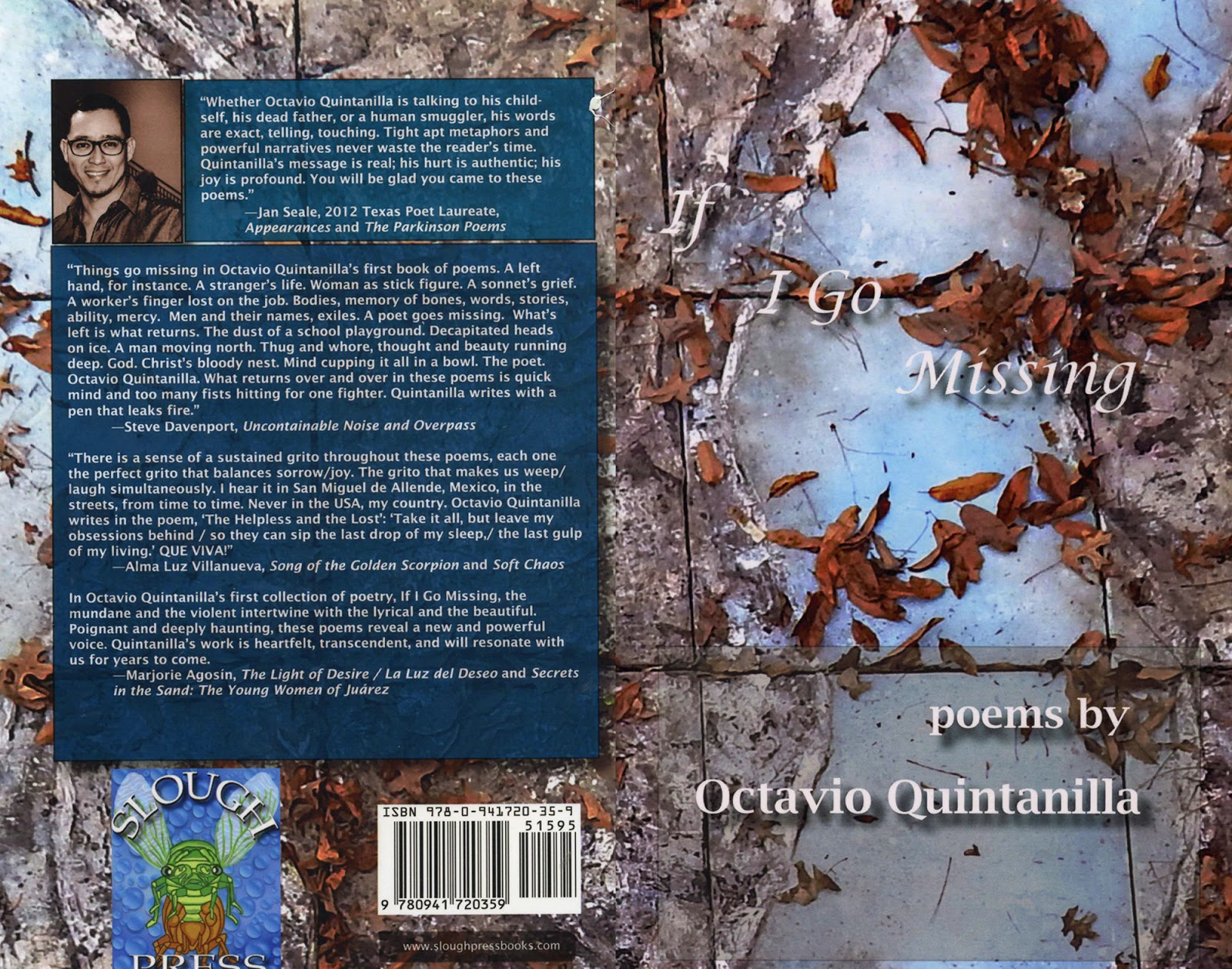 |
| If I Go Missing (Slough Press, 2014) by Octavio Quintanilla |
 |
| Catalina Cantú and her poem on the bus |
Blog: La Bloga (Login to Add to MyJacketFlap)
JacketFlap tags: 2013 Blue Lynx Prize, Los Angeles poetry, Lynx House Press, Noir poetry, Open 24 hours, Suzanne Lummis, Add a tag
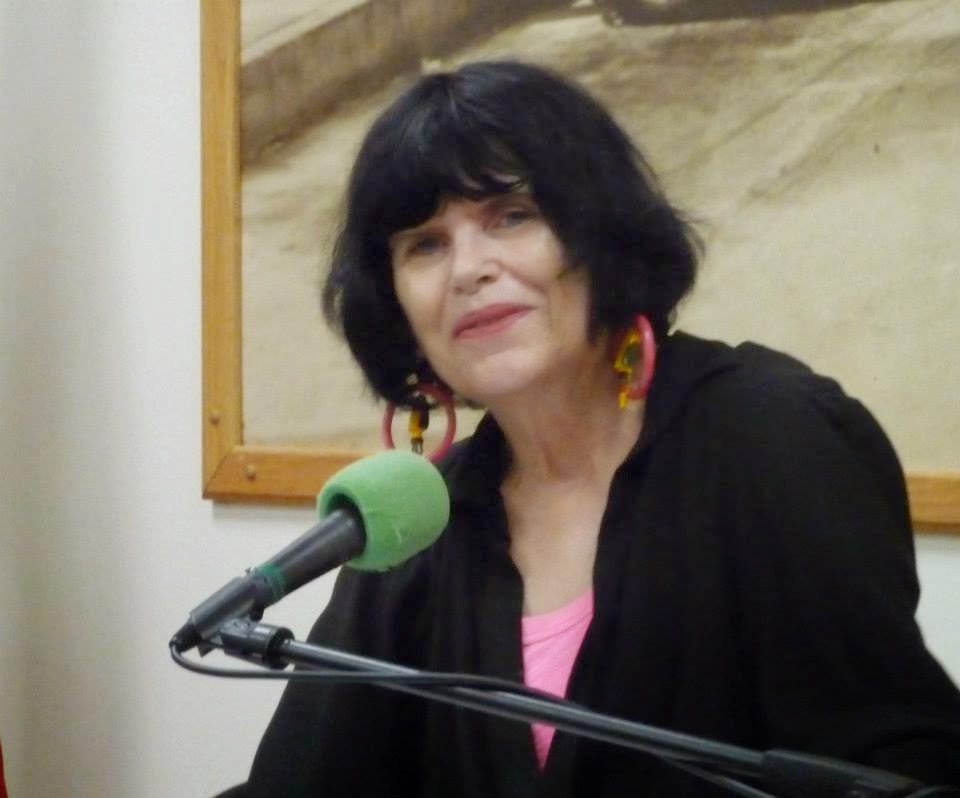 |
| Photo by Phil Taggart |
Suzanne Lummis' book Open 24 Hours won the Blue Lynx Poetry Award, and was just released by Blue Lynx Press this fall. Her poem "How I Didn't Get Myself to a Nunnery," appeared in the November 3 issue of The New Yorker. And—for contrast—she has two poems in the new anthology of noir poetry and crime fiction, Noir Riot, from Gutter Books. Suzanne is a long-time, influential teacher for the UCLA Extension Writers' Program, and the editor of the anthology to be published in 2015, Wide Awake: Poets of Los Angeles and Beyond, from The Pacific Coast Poetry Series, which was founded by Henry Morro.
Blog: La Bloga (Login to Add to MyJacketFlap)
JacketFlap tags: Ask A Mexican, Paolo Bacigalupi, #DiversityInSFF, Sasquan, WorldCon 2015, Chicano spec lit, doubt factory, latino kids lit list, political in YA lit, sffwa, silvia moreno-garcia, Add a tag
 Spec author Silvia Moreno-Garcia just posted this on FB: "SFWA sucks [something]. Sorry if you like it, but I am so bored with it…. Next year I'm spending my membership money on some other banal thing that brings me more joy. Like a fancy octopus plush toy."
Spec author Silvia Moreno-Garcia just posted this on FB: "SFWA sucks [something]. Sorry if you like it, but I am so bored with it…. Next year I'm spending my membership money on some other banal thing that brings me more joy. Like a fancy octopus plush toy." "Paolo Bacigalupi [and Alaya Dawn Johnson] are attempting a path in their latest books, thrillers that don’t just marry the personal to the political, but exploit the fantastical conventions of genre to make a head-on critique of the contemporary political landscape.
"Paolo Bacigalupi [and Alaya Dawn Johnson] are attempting a path in their latest books, thrillers that don’t just marry the personal to the political, but exploit the fantastical conventions of genre to make a head-on critique of the contemporary political landscape. |
| a VERY Chicano-political fantasy novel |
Blog: La Bloga (Login to Add to MyJacketFlap)
JacketFlap tags: Add a tag
Heh-heh.
Now I find myself 24000 words into the story and, right on schedule, the Great Doubt sets in.
Great Doubt is an old acquaintance. He made his first appearance back in high school when my father moved us from the small town (Florence – pop. 3000) in which I had grown up to the big city (Colorado Springs – not so big after all, as it turned out.) All of my life (I was 14 when we moved) my small town friends and I had been looking forward to when we would be the cool guys, the older guys, the guys having all the fun. Driving cars. Trips to Pueblo, the land of smooth Chicano soul music and soulful Chicanas who seemed to know more about the important things in life than any young lady in Florence. Making out. The Wiggle-Wobble. Hanging out with musicians, star athletes, and friends home from basic. Fake I.D.s to get in the clubs that had live music.
Instead, I ended up in a school where I didn’t see many “cool” guys – just a lot of white boys who had been together since kindergarten and who were not exactly welcoming to the new Mexican kid. That is, until I made the varsity wrestling team and started winning matches and the squad earned the right to be called a genuine challenger for the league championship. Then Great Doubt would show up before every match and I would have to force myself not to throw up on the mat until I had the first takedown. We won the championship but I flubbed my second district match and messed up my chance to go to the state tournament, even though I was a #2 seed. Great Doubt laughed so hard he fell down and rolled around the mat with his legs wiggling in the heavy gymnasium air like a dying chicken.
I went through stages of college and law school antics – political, social, and artistic. Each stage had its own share of frustration and success, but always good ole G.D. was right there. So on and so forth through marriages, children, trying to establish a law practice. Eventually, I returned to writing.
I repeat: Now I find myself 24000 words into the story and the Great Doubt sets in.
Where the hell is this going? Who would want to read this stuff? What if I can’t finish it? What if I do finish it and no one wants to publish it? What if I get it published and no one wants to read it? What if people do read it and don’t like it? What if they not only don’t like it, they hate it? What if they hate me because the book is so terrible?
Whoa.
Calm down. Chill. It helps to remember that I’ve been down this road before. I have always made it to the end. If I don’t, what’s the worst that can happen? I tell myself that no one has a gun to my head. I can always do something else. I hear collecting stamps is an interesting and educational hobby. And one can’t get too much exercise, can one? How about homemade wine? Origami?
Maybe I don’t have enough suspense in the plot? Plot? More dead bodies? More anti-hero angst? Who the hell came up with the idea of Chicano noir?
The questions continue until eventually I realize that the only way to answer them, and, thus, stop them, is to write.
Write. What a concept.
Where’s the inspiration when I need it?
Just saw a t-shirt with the phrase “You are dangerously close to being killed off in my novel.” There’s a thought. Revenge writing. Who deserves it? Better yet, who's entitled to it? Oh, that one guy, the s.o.b., yeah. But ... what if he recognizes himself and wants an apology? What if my apology isn’t enough? What if …
________________________________________________________________________________
Denver writer Antonio Garcia passed on the good news that his book, The Portal of Light, has been selected as winner of the 2014 USA Best Books Award for the category Non-Fiction: Multicultural.
The Portal of Light was also a finalist for the category Religion: Eastern Religion.
Here's part of the press release about the awards.
Jeffrey Keen, President and CEO of USA Book News, said this year’s contest yielded over 2,000 entries from mainstream and independent publishers, which were then narrowed down to over 400 winners and finalists.
Congratulations to Antonio.
Alicia Gaspar de Alba and Alma Lopez Gaspar de Alba, esteemed author and artist, as well as educators and activists, are featured in this month's cover story of the Mexican magazine LeSVOZ. Congrats to Alicia and Alma.
________________________

________________________
--------------------------------------------------------------------------------------------------------------------
I'm participating in this event - will read and have books for sale.
Mystery and Mistletoe
Writer's Showcase and Book Sale
Emcee: Helen Thorpe
1330 Glenarm Pl., Denver CO
When: Thursday Night, December 11th.
Time: 6:00 to 9:00 p.m. hors d'oeuvres, readings and a cash bar
Cost: Tickets are $10. Please order your tickets in advance! Click the Buy Now button below to make your payment. Questions can be directed to our Caterer Director, Donnell Bell at Donnell Bell or by calling 719 540 8632. The deadline for reservations is Monday, December 8th, 2014.
________________________________________________________________________________
Later.
Blog: La Bloga (Login to Add to MyJacketFlap)
JacketFlap tags: Add a tag
 The midterm election was low key in Arizona. Hysteria and paranoia levels were remarkably low, though signs announced candidates as being against Obama -- and he wasn’t running for office in this state -- and repeated the word conservative.
The midterm election was low key in Arizona. Hysteria and paranoia levels were remarkably low, though signs announced candidates as being against Obama -- and he wasn’t running for office in this state -- and repeated the word conservative. All things that a lot of Arizona voters like to hear. Especially the businessman thing. You keep hearing it: “Get a businessman in there -- that’ll fix things!”
All things that a lot of Arizona voters like to hear. Especially the businessman thing. You keep hearing it: “Get a businessman in there -- that’ll fix things!”Blog: La Bloga (Login to Add to MyJacketFlap)
JacketFlap tags: Add a tag
Blog: La Bloga (Login to Add to MyJacketFlap)
JacketFlap tags: poetry, memoir, poems, veterans, Floricanto Movement, veterans day, review, Add a tag
Veteranspeak, or 5 Questions To Ask a Veteran
Michael Sedano
| MiG Alley below, Homing All the Way Killers above |
I’ve been a Veteran since August 1970, forty-four years since I walked away from Ft. Lewis Washington, discharge in hand but still in my Class A uniform. In a curious parallel, that was early in the predawn darkness, just like that January day in 1969 when my busload of inductees stood in the predawn fog of Ft. Ord.
Ever wonder what to say when you learn someone was once boots on the ground? Veterans of my era will spin you some memories to one or more of these conversation ice-breakers. I was Army, other services have similar answers. Kids from Bush and Obama’s Iraq and Afghan wars are likely to understand the questions--the answers are the cement that links a majority of Veterans with one another.
What was your MOS?
Military jobs have code numbers, the Military Occupational Specialty, M.O.S. The best known is eleven-bravo, 11B, Infantry. Me, I was trained as an oh five bravo intermediate speed morse code radio operator, a defunct trade in military communications, even then. Assigned to a rugged anti-aircraft missile site guarding MiG Alley at the Korean DMZ, I worked an oh five charlie field wireman's job. Mid-tour I lucked out and took a job in the Colonel’s office, writing military propaganda as an acting 71Quebec Information Specialist.
 |
| Short and Shorter. Sedano 3d from right, with shades. |
Short, short-timer. We counted the days until we would “get back to the world.” Upon arrival overseas, clerks calculate your Date Estimated Return from Overseas. If all goes as planned, you’ll be heading for the airport on your "dee-rhos" date. Not every Veteran served overseas. A stateside post meant serving the full two year hitch. Draftees doing one of the hardship tours—Vietnam and Korea—often put in a thirteenth month in order to earn discharge upon DEROS. I put in thirteen months, two weeks, three days, seventeen hours seven minutes and thirteen seconds in Korea, but who’s counting, que no?
RA or US?
Did you sign up, or were you Drafted? Draftees were assigned US serial numbers, volunteer tipos were Regular Army. On the sidelines were ER and NG, Enlisted Reserve and National Guard. The latter pair did Basic Training then went home. Everyone in today’s military are RA, or in barracks vernacular, Lifers. For a long time I knew my serial number by reflex. It was stamped on the dog tags to identify our bodies. I've forgotten the number now, and that's a good thing.
Would you want to see your grandchildren in uniform?
Not involuntarily.
Would you do it again?
Gente I know, to a man and woman say, Yes. I told an Army recruiter friend that I would go if I could take the place of one of the kids he was signing up. No way in Hell would I volunteer for the Draft, but if they called me again, I'd go.
Veterans and active duty wearing a uniform get free chow at a number of chain restaurants today. A DD214 gets you fed, too. So there's that.
Veterans get to understand important yet amorphous concepts like Duty and Honor. I remember telling a friend about my cannon fodder post had the north invaded. The friend asked why I would hold my ground instead of running before it was too late? I told him it was my Duty. His eyes told me I was a fool. Así es.
 |
| Not short. |
Take This Man Grossly Captivating Memoir
Review: Brando Skyhorse. Take This Man. NY: Simon & Schuster, 2014.
Michael Sedano
Take This Man, along with its author Brando Skyhorse, occupy a unique spot along the continuum of U.S. ethnic literatures. These people, Brando and his mother, aren’t chicanos, but could have been. And they aren’t Indians, but they’re passing. His mother prefers fantasy history and invented Indianness, she becomes Running Deer Skyhorse, her son Brando Skyhorse, son of a chief. This is Identity run awry.
 Take This Man revolves around Maria Skyhorse’s story, but at the memoir’s core lives a boy looking for a father in the men his mother regularly brings home. They all leave. Then she finds a replacement. Herein lies a challenge for readers: don't judge.
Take This Man revolves around Maria Skyhorse’s story, but at the memoir’s core lives a boy looking for a father in the men his mother regularly brings home. They all leave. Then she finds a replacement. Herein lies a challenge for readers: don't judge.Maria’s acts gouge with such ferocity they steal the spotlight from Skyhorse’s more intimate explorations, overwhelming the author’s memories in his struggle to sort out identity and family and fatherness from his mishmash of an upbringing.
Skyhorse engrosses his reader with sordid details that make it tough to like that woman, Brando’s mother. While disgusted readers will grow furious at events, the author denies them an ally in their feelings. Skyhorse's tone is nearly emotionless, he refuses the reader's escape valve for the horror. The only release is turn the page, there's more.
It’s hard not to judge the people Skyhorse had in his life, not to want to spread chisme about those lowlife fathers, so consistently awful the child’s memory of fathering is a guy ferreting out hiding places, robbing piggy banks to buy a night’s drinking and gambling. Mother's not dumb but the easy way out is her route, such as her work-at-home telephone sex worker job. It brought in good cash and she didn't have to give up her food stamps. Marie laughed, ate well, and grew fat.
The little boy’s life is so gutwrenching I find myself wondering that people like this live among us, asking myself, he can’t be making up this stuff, can he? Skyhorse pulls off a tour de force voicing disarming neutrality. Animated wit and punch-line paragraphs add depth to the mostly fast-moving account. It’s a challenge separating the creative from the nonfiction. Just turn the page.
The crud just piles up for this boy. Five husbands, lots of boyfriends, flings on the road, Vegas, Reno, Tahoe, ritualized humiliations. One example suffices to illustrate the savagery of Brando’s mother, her insanity, and Skyhorse’s own neutrality as he recounts a time he couldn’t produce some coupons to pay for a bus.
The mother shouts, I’ll just leave you here! You’ve taken enough of my life from me! Mother’s fury and hatred for men finds at-hand Brando easy pickings, normally with her mouth. In this instance, however, Maria gets lethally physical.
My mother grabbed my throat. Then she pulled me across the trailer the way a girl would drag a lifeless doll up a flight of stairs. She threw me shivering onto the bathroom floor and then snatched one of Nakome’s leather knife holsters and stabbed at my neck with it…. My mother wrapped her hands around my neck again and pushed my face in the toilet water while I flailed my short arms trying to reach the flush handle.
After Maria locates the boxtops she explains to the son how his carelessness led to the bathroom incident. Skyhorse matter-of-factly clarifies her logic for the reader, Not being given the box tops wasn’t an excuse; I should have asked for them.
The slight bitter aftertaste here is among the few instances where the memoirist’s otherwise controlled voice deviates from its straightforward, low-affect style. This son does not judge his mother. The author, ever a good son, won’t have readers criticize her, either. That’s just the way she was, this is what is available to remember.
Which, of course, is not what happens. Brando Skyhorse, the writer, isn’t disingenuous in what he’s chosen to recall and detail. That mother so burdens his life it takes over the book. The son-writer runs out of room for his main goal, and only skims the surface of the boy’s understanding of fathering and his relations with his biological father and daughters. Then again, the author notes, he hasn’t got this worked out yet.
With Take This Man, Brando Skyhorse should have exorcised the demons of his mother and fathers. He said good things about most of the men. He was kind to his mother and in that way gets back at her. Now the author can rekindle the spark seen in Madonnas of Echo Park, and hinted at in the Bukowski homage of this memoir, to drop the "creative non-"and get on with it.
On-line Floricanto for November 11, 2014
Elizabeth Cazessús, Henry Howard, Ashley Garcia, Jackie Lopez, Iris De Anda
Los Rehenes, Elizabeth Cazessús
Guilty of Being Brown (Showdown in Arizona), Henry Howard
Illegal, Ashley
Blessing for James' Place, Jackie Lopez
#bringbackourgirls, Iris De Anda
Los Rehenes
Por Elizabeth Cazessús
…el viento del crimen a la altura del delirio.
Rodolfo Hasler
es la hora de escribir un poema acerca del mundo
de diagnosticar las formas en que amedrenta
con su odio y deslava el rostro de la sinrazón
para justificar mil malabares políticos
es hora de escribir que estamos al acecho
de ladrones, de gangsters, de la avaricia
de la falta de libertad y la zozobra
de la mezquina relación de las entelequias
es hora de callar lo escrito
aquello que no tiene razón en la sobremesa
congestionadas las entropías mediáticas
ante verdades telúricas y tan llanas
es hora de nombrar en lo oscuro
la íntima ejecución de los días
la denuncia, el porvenir y la esperanza
con un silencio atroz que no deje dudas
es hora de contar metrallas, muertos, a los que corren,
de ver la película en las calles y al desnudo
dilucidar acaso en la espesura
de ciertas e inexplicables densidades
es hora de escribir un poema acerca del mundo
de éste y no del otro repleto de metáforas
ya no podemos escapar, no hay letras de salva
Somos rehenes de la impunidad que nos cohabita.
(del libro Hijas de la Ira)
Guilty of Being Brown (Showdown in Arizona)
By Henry Howard
I had a nightmare the other night.
I dreamed I went to buy the morning paper,
And the headline screamed
For all the world to see,
“SB1070 Declared Fully Legal!”
And I cried, because I knew
I was now legally unwelcome here.
My mother took the paper and milk from me
With trembling hands,
And told me in her soft Mexican voice
That Papa had been arrested on his way to work.
For the crime of driving without a Green Card,
He was found Guilty of Being Brown.
We did not have time to kiss him goodbye,
Or even make him a sandwich
On his way back to a country he had not seen
In twenty years.
I woke with my heart pounding,
And my eyes full of tears.
I slowly relaxed,
Realizing it was just a dream.
Then I drove to the store in my first car,
And the morning paper screamed
For all the world to read,
“SB1070 Declared Fully Legal!”
It was my 16th birthday,
and now I, too,
Had been found Guilty of Being Brown.
 I am a Los Angeles activist and Peace Poet, whose literary focus has been on human rights since 2001. Published most notably as a featured writer on Quill and Parchment.com, and the legendary Sam Hamill's global anti-war poetry protest, Poets Against the War (beginning in February, 2002), my most recent work was published as a full-length compilation of peace and justice poetry called "Sing to Me of My Rights: Poems of Oppression and Resistance" (editor/publisher Mark Lipman, Vagabond Books 2014). Immigrant rights have been a focus of my street-level activism since 1980, when I learned in college of the murder of El Salvador Archbishop Oscar Romero--followed, of course, by the rape/murder of the four U.S. churchwomen that December. I was active in the Sanctuary Movement from 1984-98, and a member since 1986 of Refuse and Resist! and La Resistencia. I have never been to our Southern border, but it looms large in my consciousness. The horror of our country's involvement in the collective Central American slaughter, and the residual xenophobic policies towards immigrants, both documented and undocumented, reflected in legislation such as SB1070, haunts me to this day, and inspires me to take to the streets. I have one philosophy that sums up all my activism, including my writing: NO HUMAN BEING IS ILLEGAL!
I am a Los Angeles activist and Peace Poet, whose literary focus has been on human rights since 2001. Published most notably as a featured writer on Quill and Parchment.com, and the legendary Sam Hamill's global anti-war poetry protest, Poets Against the War (beginning in February, 2002), my most recent work was published as a full-length compilation of peace and justice poetry called "Sing to Me of My Rights: Poems of Oppression and Resistance" (editor/publisher Mark Lipman, Vagabond Books 2014). Immigrant rights have been a focus of my street-level activism since 1980, when I learned in college of the murder of El Salvador Archbishop Oscar Romero--followed, of course, by the rape/murder of the four U.S. churchwomen that December. I was active in the Sanctuary Movement from 1984-98, and a member since 1986 of Refuse and Resist! and La Resistencia. I have never been to our Southern border, but it looms large in my consciousness. The horror of our country's involvement in the collective Central American slaughter, and the residual xenophobic policies towards immigrants, both documented and undocumented, reflected in legislation such as SB1070, haunts me to this day, and inspires me to take to the streets. I have one philosophy that sums up all my activism, including my writing: NO HUMAN BEING IS ILLEGAL!Contact me about the poem or order my book. I am also available for readings at public and private events, and will travel to Arizona, Northern California or Nevada to share my work at open-mic events. EL PUEBLO UNIDO! JAMAS SERA VENCIDO!
Illegal
By Ashley
You say I am illegal because of my flesh,
Racism-pigmentocracy,
Separation-marginalization,
Apartheid, a race apart.
Even after the laws change,
Discrimination still exists
Cradling fear and fight of flesh-hood
Same flesh, different color.
Illegal,
So is it my flesh, my body, or my being?
You say I am illegal because of the land I stand on.
I do not belong here.
The land sits underneath the sky,
Shall we fight over clouds?
However, this is no different than the land I was born from.
Migration to illegal immigration,
I am, me, the im- in immigration,
The prefixed knot in the rope,
The prescribed not of ‘im’ and ‘il’
Illegal,
So is it the land, my body, or my being?
You say I am illegal because of love,
An endearing criminal at best,
Same heart, different passion,
Love is not a crime.
What matters is within:
not the shape of our skin
377: I went sleep in 2013 and woke up in 1860,
Illegal,
So is it my heart, my body, or my being?
You say the I of me, the me of I is- Illegal.
The law versus: Land, love, and life,
No! No being is illegal,
Neither my body, flesh, nor heart,
Not even my soul,
It is time,
To set my soul afire and let it free.
This poem was first published on Orinam on Dec 20, 2014 at http://orinam.net/illegal/ and is being republished with permission of the author
Ashley was born and raised in Southern California. Her parents are from Mexico. Ashley has been published both online and in-print. A poet, aspiring writer, and is currently learning classical dance. This poem "Illegal" was first published on Orinam on Dec 20, 2014 at http://orinam.net/illegal/ and is being republished with permission of the author
Blessing for James' Place
By Jackie Lopez
James, I bless you from the tip of my hat to the bottom of your feet.
James, never covet another’s house because your place is blessed for having feasted.
I do believe you are entitled to a blessing.
I do believe you become disjointed at the ends when I don’t come around.
Don’t worry.
I will come around every Thursday night at 7 in between meals.
I happen to have happiness around.
I happen to have a misnomer claiming that I am “mad,” but that is how it should be
because I am quite the crazy little pajama party girl.
The mockingbird is singing outside of your studio.
The melancholy moon is twisting in her bed.
She heard you have blasted fun.
The pavement to your studio has been watered by daffodils.
The encouragement of the nonchalant is ever present.
There’s an artistic renaissance running around naked in your studio.
There’s a show girl at your doorstep.
There’s a criminal lurking around, but you know better, there is never a love that can be considered a crime.
If you watch your watch words, you will find me misbehaving.
When I was lost and had no matrimony to offer,
you took me in.
When the painters, poets, musicians, prophets, dancers, and one-night-stands came by,
you gave them an apple dessert to eat.
It so happens that I have come a long way from my home,
and I am able to salute you on a happening basis.
When the ticket to the train I was going on fell through,
I took to hiding in between the sheets.
Now I have you to call friend.
If ever you need a helping hand, if ever you are lonely and blue, call me telepathically.
I shall send the angels to rescue you because you deserve it, James Watts-and you, too, Juan Pazos.
Thursday night dinner is for dancing and being ludicrously in love.
It is for harnessing a misbehavior and going about town.
It is for the young at heart and for the philanthropists.
I summon all the powers of the Universe Complete to bless your studio now
and forevermore or for as long you endeavor to stay home.
When I saw your rocket scientist artwork, I became a lucid woman.
Simple things mean so much more when they are shared with friends.
So, keep on trucking.
I shall meet you on the other end of a transcendence.
Jackie Lopez is a poet and writer from San Diego. She was founding member of the Taco Shop Poets and has always pursued a study of history of which has influenced her writing. She has taught in San Diego City Schools and has been published in several literary journals. She has just finished her Magnum Opus titled “Telepathic Goodbye” described as a long poem of 25, 333 words. She is now looking for a publisher for this. You can catch her work on facebook under “Jackie Lopez Lopez” where she shares her work with a daily poem. She has a radio interview that will come out later this year. Her email: [email protected]
#bringbackourgirls
By Iris De Anda
ruby rage shouts escape
as our young girls disappear
there is no sleep
when night falls without them near
days and days and days have passed
can you remember their bright eyed brilliance
forsaken flowers with petals that wither
under boots of beatings and men with guns
they are killing them softly
raping them daily
silencing their spirit
every time one of them dies
can you feel it in your body
walk around so heavy
carry unseen sadness
on the bridge of our backs
they are our future failing
mountains crumbling
deserts flooding
stars extinguished after lightyears of shining
blood moon tainting the night sky
mothers wailing to the goddess
bring back our schoolgirls
bring back our daughters
they are the martyrs of this modern plague
where men get away with murdering women
while the world looks away
closed eyes to our girls plight
makes the whole world blind
you do not want to see
what you would rather neglect
because it’s not your daughter, sister, or niece
you pretend to respect
can you protect morning dew from the blazing sun
the young woman from the older man
a system that teaches a girls life is worth less than his pen
there is no gentle here where our daughters cry
only rivers of pain
flowing back to the Niger
years of disdain
growing darker by the hour
bring back our sisters
bring back our feminine
bring them back
backdrop of africa
blackout of femicide
backbone of generations
backyard of transgressions
giveback our girls
payback our pain
paperback our stories
comeback our angels
we are waiting
arms wide open
feet tired from running with you and for you
tongues chanting
all the ways we could pray for you
hearts broken
night and days we wait for you
bring back our girls
bring back our girls
bring back our girls
Iris De Anda is a writer, activist, and practitioner of the healing arts. A womyn of color of Mexican and Salvadorean descent. A native of Los Angeles she believes in the power of spoken word, poetry, storytelling, and dreams. She has been published in Mujeres de Maiz Zine, Loudmouth Zine: Cal State LA, OCCUPY SF poems from the movement, Seeds of Resistance, In the Words of Women, Twenty: In Memoriam, Revolutionary Poets Brigade Los Angeles Anthology, and online at La Bloga. She is an active contributor to Poets Responding to SB 1070. She performs at community venues and events throughout the Los Angeles area & Southern California. She hosted The Writers Underground Open Mic 2012 at Mazatlan Theatre and 100,000 Poets for Change 2012, 2013, and 2014 at the Eastside Cafe. She currently hosts The Writers Underground Open Mic every Third Thursday of the month at Eastside Cafe. Author of CODESWITCH: Fires From Mi Corazon. www.irisdeanda.com
Blog: La Bloga (Login to Add to MyJacketFlap)
JacketFlap tags: Add a tag
 |
| Ilan Stavans |
 |
| Lalo Alcaraz |
IN MORE LITERARY NEWS...
Blog: La Bloga (Login to Add to MyJacketFlap)
JacketFlap tags: Add a tag
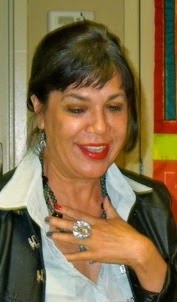 |
| Ana Castillo in San Francisco, 2012 Photo by Lisa Paul Streitfeld |
 |
| Ana Castillo, 2013 "in the Valley" |
 |
| Ana Castillo in Silver Springs, New Mexico. 2013 photo by Robert A. Molina |
 |
| Ana Castillo in Silver Springs, NM, 2013 Photo by Robert A. Molina |
Blog: La Bloga (Login to Add to MyJacketFlap)
JacketFlap tags: WIP, new stories, Chicano lit, SF/F, #WeNeedDiverseBooks, Chicano Author, latino speculative literature, Add a tag
--> I'm sapped. By election results, doctors' ignorance about strange pains that I might go half-Stephen-Hawking about, and from not having gotten really drunk in over a month.
 |
| What the children would create in Anahuac |
 |
| Non-Diné image of Diné entity |
 |
| What Chaneco tumbled down |
Blog: La Bloga (Login to Add to MyJacketFlap)
JacketFlap tags: halloween, New Orleans, yoga, Southern Orthopedic Specialists, Alter G, Anit-gravity treadmill. Julie Nail, Add a tag
| Month 4 of My Broken Leg |
 |
| Julie Nail (photo by Lerina Winters) |
| The Alter G Anti-Gravity Treadmill |
| Clicking my heels for a speedier recovery |
| There's No Place Like Home |
| In front of Molly's |
| Catching Throws from the Carriage Riders |
| Glittering Shoes is Fun |
Blog: La Bloga (Login to Add to MyJacketFlap)
JacketFlap tags: Add a tag
Blog: La Bloga (Login to Add to MyJacketFlap)
JacketFlap tags: books for children, Latino Book and Family Festival, guest writer, Gladys Elizabeth Barbieri, Add a tag
After the Q & A I got to sell and sign alongside these two gentlemen. The author sitting to the left of me, Juan Villegas, shared that he couldn’t believe he was sitting next to the Victor Villaseñor, a Mexican-American writer, best known for the New York Times bestseller novel Rain of Gold. I giggled because I understood what he meant. Juan and I looked at the super long line of fans waiting to meet and have their book signed by Victor Villaseñor because we were more than happy to sell a few books. And in just one hour Victor Villaseñor sold out boxes and boxes of books. I then discreetly pointed to René and James who were sitting to the right of me and said, “I hear you. Those two are the real deal in Latino Children’s Publishing.”
Blog: La Bloga (Login to Add to MyJacketFlap)
JacketFlap tags: DDLM, poetry, poems, Day of the Dead, readings, Floricanto Movement, Add a tag
Memorial Poetry Reading for James Foley
 |
| Among LA's hardest-working poets, Luivette Resto, Iris de Anda, Gloria Enedina Alvarez |
La Bloga friend and fútbol poetry contributor, Yago S. Cura, sends news that will have gente circling their calendars to remind of a spectacular reading of Los Angeles poets. Here's Yago's email:
Gente/Folks!
On Sunday, November 23, from 2-4 PM the La Palabra reading series will host a reading for American Journalist, James Foley, at Avenue 50 Studios (131 N Avenue 50, Los Angeles, CA 90042 / (323) 258-1435) in Highland Park.
The reading hopes to celebrate Foley's work as a combat journalist, fiction writer, and English teacher. The event will also serve as an opportunity for people to donate to the James Foley Legacy fund and the James Foley Scholarship at Marquette University in Milwaukee.
Please come celebrate his legacy with some of L.A.'s hardest-working poets: Dennis Cruz, S.A. Griffin, Billy Burgos, Annette Cruz, Millicent Accardi, Matt Sedillo, Luivette Resto, Angel Garcia, Ashake M. Jackson, oConney Williams, Ryan Nance, Rebecca Gonzalez, Gloria E Alvarez, Daniel Sosa, Iris De Anda, Karineh Mahdessian, and William Gonzalez
On-line Floricanto for Día de los Muertos
"If I Could Weigh My Memory" by John Martinez
"Baile" By Jose Faus
"Two Dia De Los Muertos Tales" By Odilia Galván Rodríguez
"Ancestor Dreaming" by Christine Costello
"A beautiful day in the neighborhood" by Sharon Elliott
"Holyhand" By Jolaoso Pretty Thunder
“My Own Louie” By Paul Aponte
"CALAVERA A GRACIELA B. RAMÍREZ" Por Betty Sánchez
"Tinta roja"/"Red Ink" Por Sonia Gutiérrez
"Altar en el desierto / Altar in the Desert" by Francisco X. Alarcón
If I Could Weigh My Memory
by John Martinez
If I could weigh my memory
Like a sack of something,
It would have the weight
Of my loving dead
My Uncle in an empty church,
Red carpet beneath
Pressed soles
My mother holding her arm
Like a wounded baby
My brother, opening
Another door to a lesson,
Still seated in the center
Of his room
Where loss and imagination
Are riddled about
And the exhale of the dying,
Is distant and furling
Through trees
If I could weigh my memory,
On the scale,
Like a gunny sacks of chili's
And beer hands reaching,
And burning sun
Scorching our skin
Browner than brown,
I would weigh it with a smile
Because the weight
Of my memory,
Summons a sum paid
And so I walk away
With the grin of a child,
Walk into a perfect landscape,
With my reward secure
In my dusty pockets
(c) John Martinez 2014
All Rights Reserved
john Martinez has published poetry in several journals, including, LA WEEKLY, EL TECOLOTE, Red Trapeze and this will be his 17th poem published in LA BLOGA. Martinez studied creative writing in the early 80's at Fresno State University under, the now, U.S., Poet Laureate, Phillip Levine and has attended seminars with several established American poets. For the last 30 years he has worked as an Administrator for a Los Angeles Law Firm and has recently complete his long awaited Manuscript of 60 poems entitled PLACES, which will be published by IZOTE Press.
Baile
by Jose Faus
She came to my door last night
like so many times before
At first I do not see her
hiding in the bushes
Turning back into the living room
her bony legs trip me
and I land on the floor
I love it when that happens
She laughs and heads for the altar
helping herself
to the ofrendas on the shelf
Hey what gives señorita
You know these are for the souls
that will come tomorrow night
Do you really think I am a señorita
She smiles coyly
the blush coloring her bleached bones
Of course my lovely
And for the umpteenth time
since we first met
I lead her to the table
and serve her tamals
baked in banana leaves
a tall glass of avena
with a hint of cinnamon
On the stove
arroz con pollo
spiced with cloves and
littered with green olives
simmers
I pour her a cup of vino de casa
and in the dim light we reminisce
Tio Jaime and tu primo Sancho
send their regrets
Emerita tu abuelita
cries over her Cuco
Give me a picture to take to her
Then she takes her finger
and slowly strokes my beard
and with the hollow of her eyes
looks deep into my heart
You know someday
I will come for you
Don’t think of work tonight my dear
I reach behind her on the table
and grab the long stem rose
She puts it in her mouth
and stands apace
I push the player to shuffle
and in a tight embrace we sway
to boleros and tangos
the rattle of her bones
an eerie metronome
I ply her with vino
until she is tipsy in my arms
Any moment she will fall asleep
and then suddenly she glides
awkwardly across the floor
stops and holds the rose
on the tips of her weary bones
These advances are so nice
to feel and be what I was once
but it is futile to resist
someday I will come for you
and what will have been
the point of this
Nada chica nada
But you can’t blame me for trying
Besides how many can claim
to have danced
with such a lovely death
cheek to cheek
in a tight embrace
Alma de mi vida
you can really shake and bake
José Faus is a founding member of the Latino Writers Collective and Writers Place board president. He is a 2012 Rocket Grant recipient for the community project VOX NARRO. His writing appears in the anthologies; Primera Pagina: Poetry From the Latino Heartland, Cuentos del Centro: Stories From the Latino Heartland, Raritan, Whirlybird Anthology, Luces y Sombras and I-70 Review. He is the 2011 winner of Poets & Writers Maureen Egen Writers Exchange award.
Two Dia De Los Muertos Tales
by Odilia Galván Rodríguez
La Calaca's
bones rattle
make sounds
como when los músicos
play la marimba
Calaca dances
down the hall
looking for people
to mesmerize
with its fancy jiggly steps
it dances street and wise
La Calaca wants to steal
anyone’s last sweet breath
and twirl them dazed
into its bony arms
of death
ஜ ஜ ஜ ஜ ஜ ஜ ஜ ஜ ஜ ஜ ஜ ஜ ஜ
La Llorona they say
drowned her children
because their father left her and
she lost the love of her life
but others say it was because
she could no longer provide
on a single mother campesina’s wages
didn’t know how to care for them on so little
that was not the life she had envisioned
she despaired for her children’s future and
went crazy from so much worry
about how to pay for care for them
while she was at work or sometimes even
where their next meal would come from
one night after crying and crying and
ravaged with so much guilt and fear
she decided it was better
to return them to the water
so they’d swim happily back
to that calm calm place
where all life begins
again
Odilia Galván Rodríguez, eco-poet, writer, editor, and activist, is the author of four volumes of poetry, her latest, Red Earth Calling: ~cantos for the 21st Century~. She’s worked as an editor for Matrix Women's News Magazine, Community Mural's Magazine, and most recently at Tricontinental Magazine in Havana, Cuba. She facilitates creative writing workshops nationally and is a moderator of Poets Responding to SB 1070, and Love and Prayers for Fukushima, both Facebook pages dedicated to bringing attention to social justice issues that affect the lives and wellbeing of many people. Her poetry has appeared in numerous anthologies, and literary journals on and offline.
Ancestor Dreaming
by Christine Costello
(Idle meandering thoughts of an insomniac)
Eyelids flutter as my curtains blow to the same beat
Flutter whoosh whoosh
Window open like a restless mind
The wind seeks sleep
perhaps a dream
Flutter snap wind
A dream awaits
A shadow passes by in the hall
A spirit conjured by the wind paces back and forth
Waiting for the sound of tires on a wet street
dripping with a hope of rain.
Dream.
Flutter.
Storm.
Spirit.
Insomnia holds me captive
under the weight of a dream
waiting to be released to a sleeping mind
Ancestor I hear your whispers
Ancestor I feel your strength
Ancestor
sleep doesn't live here anymore
Only a deep flutter of a restless night
Dancing.
Flutter.
Snap.
Sweet slumber
I beg you to quick grab the key
The key
It opens to the dream
Please open
Wrong key
Missing is the slumber
the evasive sleep I crave
Is there a key
I can't remember
Born and raised in San Francisco Christine Costello is a 6th generation San Franciscan who grew up in the Mission District. She was the recipient of the Benny Bufano Art Scholarship and attended the San Francisco Art Academy majoring in Fine Art. She has been keeping illustrated journals for 40 years. Christine still resides in the City's Duboce Triangle neighborhood. Christine was a union labor activist for many years, working for various unions after being inspired by the farm workers movement, For the last 14 years she served as Business Agent for Theatrical Stage Employees Union Local B18, Christine volunteered her services for many years as the event planner for Instituto Laboral de la Raza’s annual fund raiser. An early retirement due to a disability has once again spurred her writing, journaling and illustration. She is a priest of Yemaya practicing the Lucumi traditions as well as an espiritista.
A beautiful day in the neighborhood
by Sharon Elliott
copper calavera
helicopts
above blue seas
grey sand
gyrates
a white flower
coffee cup
dance
at the inlet
drives a car
strewn with branches
green
scarlet
periwinkle
leaves are
woven into noise
grate against
ears
too full of sound
bird
of unknown origin
calls to children
playing in the street
they shout at each other
without answering her
wings gifted to
the calavera
stop her tortuous flight
allow her
to settle on a skylight
blocks away
knock three times
dissolve through it
fluff her bony
caderas
over a purple pillow
drink a lighted candle
blow wax through her ears
smile toothily
at humans
choosing to ignore her
she decides to stay
Copyright © 2014 Sharon Elliott. All Rights Reserved.
Sharon Elliott was born and raised in Seattle and lives in Oakland. Four years in the Peace Corps in Nicaragua and Ecuador laid the foundation for her activism in multicultural women’s issues. Her book, Jaguar Unfinished was published in 2012. She was an awardee of the Best Poem of 2012, The Day of Little Comfort, by La Bloga On-Line Floricanto; and has been featured in poetry readings in the Bay Area. She is an initiated Lukumi priest of Scot/Sámi/African Carribbean ancestry; ally to people of color and to the earth.
Holyhand
By Jolaoso Pretty Thunder
I am saying datura grows in colonies
on abandoned roads on the hips of the interstate
I do don't remember what she says
lost several hours, days even
ghost rattle
I am saying the dumb sky above looked down
on my galvanized roof, my castle
and two bucks locked antlers
In front of the house
03:00 am
dragging each other 150 feet
I call the dream helper by name
It's that time again
dirt
ash
mist captured
The women of my clan tossed the family name into the pit
I too burn the bridges
goodbye
My vision can change with the invisible borders that
I see, then cross
Trespassing
Yet further
I push it, reach the edges, some kind of darkness that brightens
Don’t look in the skeleton closet
you will find me there
The town dump, ocean, ravine, last stand of redwoods
I am the rubbish of the compound
Being eaten by the village chickens
I shapeshift into the sailor, a crossroads
Then the common wife, the storm flower, perfect whore, your queen
I am on the porch tethered to a cinderblock that lays in the crabgrass
This is exile self chosen
I nap in the sun
Irresponsible
Drawing it out with a stick in the dirt
I am the green hoop around the sun
on far away days
I see you in your manner
I speak in your Way
Dressing the house in tea and cakes
Spirit plates left for the dead
I know the songs for war, love, invisibility and undoing the sorcery
I tie knots in the rhythm
I say outright you have abandoned your own self
I say to you, those matching dishes and pillows are your spirit, malnourished
That formal garden, the same
I speak that I fear my own black magic and what I can do
what I have already done
I say I know these trees and which way to glance to accomplish it all
Blood in the hollow
1234567
This is what I am saying
This is the language I speak
Jolaoso Pretty Thunder is an initiated Apetebi and Orisa priestess of Oya in the Lukumi tradition. She lives in the woods of Northern California with her two dogs Rosie Farstar and Ilumina Holydog. She is a certified practitioner and student of herbal medicine (Western, Vedic, TMC and Lukumi) and is an ordained minister of First Nations Church. She is a well traveled poet and loves southern rock, porch swings, pickup trucks, cooking, camp fires, lightning, steak, long drives, hot cups of coffee, gathering and making medicine and singing with her friends and family.
My Own Louie
by Paul Aponte
You know, Capitol Avenue en SanJo.
Way Before some güey
decided to express it
by demolishing cantones
and turning it all
into a cesspool
of boiling concrete & cars.
Anyway,
Andábamos en su ranfla
down Capitol Avenue.
El Louie was driving Dad's
46 Plymouth Coupe
From Story Rd
down Capitol Avenue
approaching el Payless.
Payless:
with the huge drive-in type parking lot
where jainas and vatos hung out at night,
listened to "Angel Baby" and "Hanky Panky".
.
but right now it was daytime,
and two of his buddies
con su ranfla chingona
came up right next to his window.
.
With lip-bobbing cigarette he said:
"Ey, Louie you got a match!"
"Órale. Hold on.
Poly, drive the car.
"Qué?"
Just grab the steering wheel!
El Louie sat on the window sil
paper matches in hand
lit up three together to make sure,
lit the vatos trola,
and sat down
before the carrucha
complained
about the 8 year old steering it.
.
He gave me a couple of looks
and on the 2nd gave me his signature laugh:
"Puh-th-th-thuh".
He drove me to Mark's Hot Dogs,
the place with the juiciest,
crispiest and most delicious dogs,
making me feel welcome again.
.
My summer vacation from el Defe,
starting off pretty well.
.
He'd been there, himself.
Got a tough guy reputation
in a place filled with the toughest.
Constantly came back to our Tlatelolco apartment
beat up for taking on too many at once.
I imagine they called him el Tlate-loco.
So the uncles had to send him back to SanJo.
I never saw any meanness.
I only saw crazy funny,
or quiet, wistful, pensive Louie.
Though, most times he was out and about.
.
Even so, I do have some memories.
Like that hot summer night
when he was stuck at home for some reason.
He gave me a note, and instructions:
"All you have to do is knock on the window.
When Sylvia opens it, tell her Louie sends this.
Now, go!"
I knock, and Sylvia opens the window
immediately grabs the note without asking
and tells me to wait.
She comes back out with her thick eye-liner,
and puffy hair with the flipped out ends
and straight cut bangs barely above her brows.
she gives me another note to give to Louie.
Then I become a ping-pong ball on the
table of grounded teenagers.
I know at some point it stopped,
but I actually don't remember that moment.
I think the ghost of me or parallel universe me
is still out there doing it.
.
He was definitely the ladies man,
and even though he was tall & studly,
with light skin & light blue eyes,
he liked them gorditas, prietitas y bien Chicanas.
Le gustaba la guitarra just like Dad,
and he impressed the ladies just like Dad.
.
The summer was over.
Back en el Defe things began boiling.
Just like everywhere around the world and the U.S.
.
1968 came around - a horrific year.
The beginning of the Tet Offensive in Vietnam.
Labor strikes and riots in Poland, France & Italy.
Race riots throughout the U.S.
President Johnson refused to run for re-election.
Martin Luther King - assassinated.
Bobby Kennedy - assassinated.
Student riots in Mexico City.
Estudiantes contra granaderos.
In Tlatelolco where I lived -- many students were murdered.
and in 1968 ...
Mi carnal Louie died. He was 18.
He died March 30th, 1968.
.
The newspaper said he drowned in Coyote lake.
Maybe he drowned in sorrow
after his good friend
committed suicide.
Maybe he abused his body
and just couldn't come back out.
Maybe, as they say, he was involved with gangs
and was killed when he chose to lead a different gang,
beaten up and thrown in the water
at a supposed "going away" party.
.
Don't want to know.
.
Years after:
My sister's daughter was born ... on March 30th.
My son was born ... on March 30th.
There is a supernatural feeling about that.
.
I think it was 1970
cuando me retaché a mi dulce hogar
for the summer.
I remember getting a high fever, almost delirious.
In the depths of my illness
I actually felt myself feeling like I might die.
Casi estiraba el teni.
Then I had a dream.
I was in the middle of the main road
in a typical western town of the old wild west
a strange town, unknown to me
deserted dirt streets
rolling tumbleweeds.
I realized I was going to be in a gun fight.
The other guy showed up at a long distance
on this main town road
in a hero's style cowboy outfit
with a red scarf blowing in the wind
I knew it wasn't my town
I knew this man meant business
and I had no business being there.
His arms slightly out, hands wide open by the holsters.
Then I saw it was Louie.
His message was “this town, his town, ain't big enough for the both of us”.
.
After I recuperated from my fever,
and was playing outside on a windy day,
I thought I heard in the wind, his signature laugh.
"Puh-th-th-thuh".
Paul Aponte is a Chicano poet born in San Jose, California USA, and now a proud citizen of Sacramento. Paul, was a member of the performance poetry group "Poetas Of The Obsidian Tongue" in the 90's, and now is a member of "Escritores del Nuevo Sol". He is the author of the book of poetry "Expression Obsession" published in 1999, and has been published in "La Bloga" and in the book "Un Canto De Amor A Gabriel Garcia Márquez" which was put together by Alfred Asis from the country of Chile to honor Gabriel Garcia Márquez with poems from around the world with 31 countries represented. Through his many poems in English, Spanish, and Spanglish he conveys a connection to his culture that transcends the material. He does this while retaining a voice that is very clearly his own, one which he commands with sincerity and a truthful, even wise sense of humor, and of self. Facebook website.
CALAVERA A GRACIELA B. RAMÍREZ
por Betty Sánchez
Se ha esparcido la noticia
Usted no lo va a creer
Graciela Brauer Ramírez
Ya ha dejado de ser
Con el Creador hizo un trato
De llegar a los sesenta
Pero al llegar a esa edad
Se fue a comprar indulgencias
Y rebasó los ochenta
Se murió placidamente
Esbozando una sonrisa
Logró lo que tenia en mente
Cruzó esta vida sin prisa
En vida fue muy activa
Practicaba el Tai Chi
Tenia otras perspectivas
Eso apenas descubrí
Tres maestrías completó
Se la pasaba leyendo
Sus memorias registró
Como le hizo no lo entiendo
La muerte llegó en carreta
A recoger sus huesitos
Vio dormida a la poeta
Y se robó sus escritos
El sol de los escritores
Se ha eclipsado de momento
Muy tristes le llevan flores
Perderla es el peor tormento
Los ángeles y el chamuco
Por su alma se pelean
Han armado un emboruco
Uno y otro forcejean
Ni pa’ ti ni para mi
Dijo el demonio enfadado
Esto ya lo decidí
Echémonos un volado
La parca que no es paciente
Les arrebató a su cliente
Se fue directo a los cielos
Para evitar mas recelos
En la puerta la esperaban
Con maracas y tambores
José Montoya y Phil Goldvarg
Para hacerle los honores
Tremenda pachanga armaron
Que les costó el paraíso
Al infierno los mandaron
Para volverlos sumisos
En la tierra los mortales
Añoran a su poetisa
De vez en cuando hay señales
Que nos visita la occisa
En México se aparece
Por la calle Bucareli
Ahí transcurrió su infancia
Sus recuerdos no perecen
Alguien asegura verla
En las aulas de Sac State
Acaso eso nos sorprende
Si por veinticinco años
Su enseñanza aun trasciende
El averno esta de gala
Se organiza un floricanto
La calaca se acicala
Luciendo su mejor manto
Graciela es la invitada
Que a todos deleitará
Con su épica chicana
Si una grulla ven volando
No es una pájaro cualquiera
Es ella que esta extrañando
Sus hijos nietos y amigos
Los árboles y los ríos
de ésta su amada ciudad
Que aun sigue visitando
Adiós viejecita linda
En mi corazón te llevo
Con respeto se te brinda
Ésta plegaria que elevo.
Con todo mi cariño y admiración para mi querida Graciela B. Ramírez
28 de Septiembre de 2014
 |
| foto:Andres Alvarez |
He colaborado en eventos poéticos tales como el Festival Flor y Canto, Colectivo Verso Activo, Noche de Voces Xicanas, Honrando a Facundo Cabral, y Poesía Revuelta.
Ha sido un privilegio contribuir en la página Poetas Respondiendo al SB 1070, Zine 10 Mujeres de Maíz y en La Bloga.
Tinta roja
por Sonia Gutiérrez
“Si tú mueres primero, yo te prometo . . .”
—Julio Jaramillo, “Nuestro juramento”
Hace unos minutos
vino mi Lola.
Estuvo aquí.
Sentí su presencia
como un zarape
cálido sobre mi cuerpo,
y sus colores
como rayos de luz
llenaron mi corazón.
En el cuarto junto
a mi alcoba,
donde nuestros cuerpos
florecían y perfumaban
las noches, ella misma
encendió la música
con su llanto.
Me visitó mi Lola
para que juntos
escucháramos
la guitarra,
las palabras,
y los gemidos
de nuestra canción.
Y entonces las paredes
y los santos recordaron
nuestros besos, nuestras caricias.
Estoy contento.
Estuvo aquí mi Lola;
cumplimos nuestra promesa,
y Ay como le agradezco
su visita para que ella vea
que tomé la pluma roja
y recordé
nuestro juramento.
Red Ink
by Sonia Gutiérrez
“Si tú mueres primero, yo te prometo . . .”
—Julio Jaramillo, “Nuestro juramento”
A few minutes ago,
my Lola came.
She was here.
I felt her presence
like a warm
zarape over my body,
and its colors
likes rays of light
filled my heart.
In the room next
to my bedroom,
where our bodies
flowered and perfumed
the nights, she herself
turned on the music
with her cry.
My Lola visited me,
so together
we could listen
to the guitar,
the words,
and the moaning
of our song.
And then the walls
and the saints remembered
our kisses, our caresses.
I am happy.
My Lola was here;
we kept our promise,
and Oh how much I appreciate
her visit, so she could see
that I took the red pen,
and remembered
our oath.
Translation by Sonia Gutiérrez
Sonia Gutiérrez is a poet professor, who promotes social justice and human dignity. She teaches English Composition and Critical Thinking and Writing at Palomar College. La Bloga is home to her Poets Responding SB 1070 poems, including “Best Poems 2011” and “Best Poems 2012.” Sonia recently joined the moderators of Poets Responding to SB 1070.
Her vignettes have appeared in AlternaCtive PublicaCtions, Storyacious, and Huizache. Her bilingual poetry collection, Spider Woman/La Mujer Araña, is her debut publication. Kissing Dreams from a Distance, a manuscript written in the Tomás Rivera and Sandra Cisneros literary tradition, is under editorial review. “Tinta roja” first appeared in Tijuana poética #7 / octubre 2014.
Altar en el desierto / Altar In the Desert
by Francisco X. Alarcón
 |
| foto:Javier Pinzón |
 |
| foto:Javier Pinzón |
Blog: La Bloga (Login to Add to MyJacketFlap)
JacketFlap tags: M. Miranda Maloney, pandora lobo estepario press, The Lost Letters of Mileva, The Smithsonian Latino Virtual Museum, Add a tag
 |
| THE LOST LETTERS OF MILEVA BY M. MIRANDA MALONEY |
 |
| M. Miranda Maloney |
 |
| CHIAROSCURO/CLAROSCURO BY ÁLVARO TORRES-CALDERÓN |
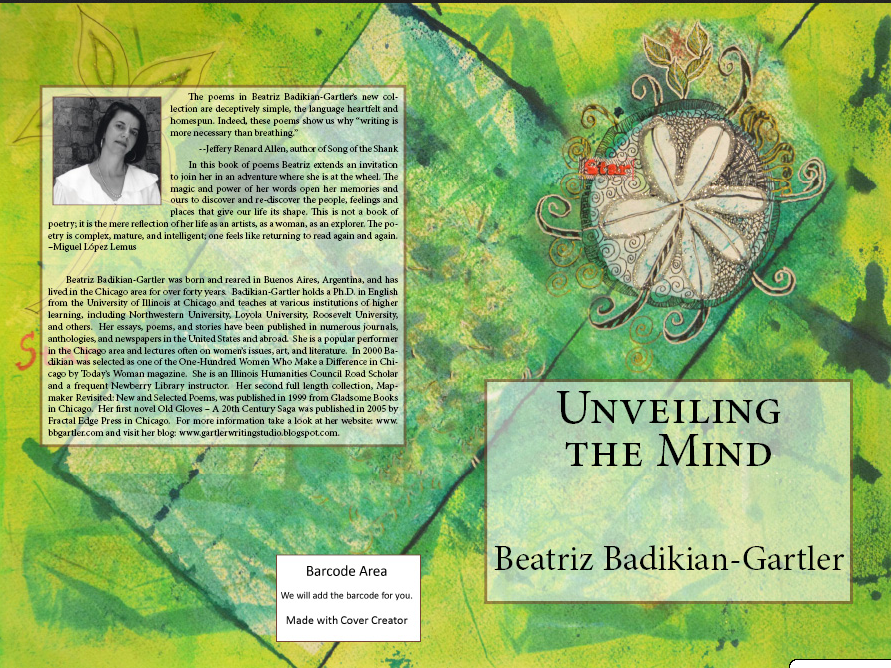 |
| UNVEILING THE MIND BY BEATRIZ BADIKIAN-GARTLER |
 |
| Aurora Anaya-Cerda, La Casa Azul Bookstore, in New York City |
 |
| Liliana Valenzuela in Austin, Texas |
| Mark Statman in New York City |
 |
| Pop Up Art Gallery in Kansas City, MO |
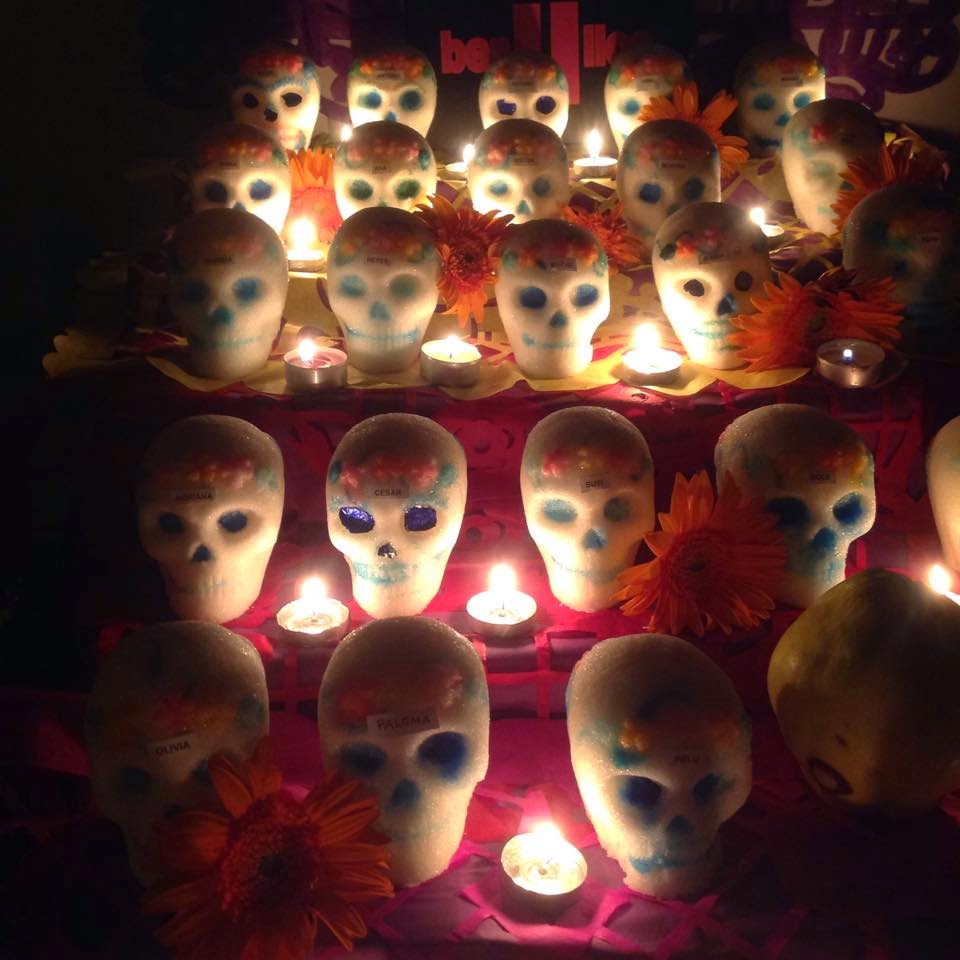 |
| Adriana Manuela in Puente Genil, Spain |
 |
| Alberto Lopez Serrano in San Salvador, El Salvador |
 |
| Rigoberto Gonzalez in New York City |
 |
| Norma Cantu in Kansas City, MO |
 |
| Diana Pando in Chicago |
 |
| Raul Sanchez, Los Norteños Writers, Seattle, WA |
 |
| University of North Georgia |
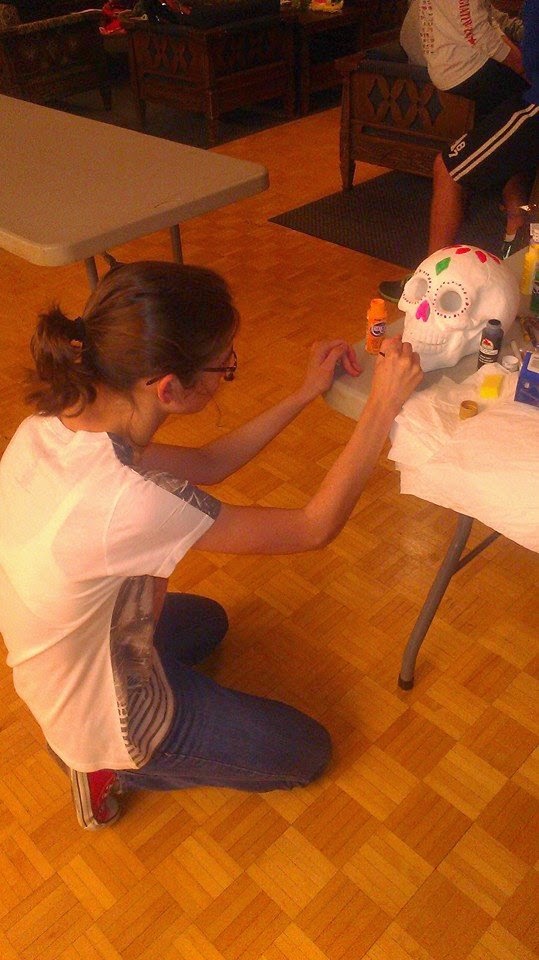 |
| University of North Georgia |
 |
| The Smithsonian Latino Virtual Museum, Dead Poets Reading & Open Mic: Liliana Valenzuela, Rosa, Viva Flores, Celina Villagarcia, Xanath Caraza, Melissa Carrillo, M. Miranda Maloney |
Blog: La Bloga (Login to Add to MyJacketFlap)
JacketFlap tags: Add a tag
 |
| José Guadalupe Posada |
Blog: La Bloga (Login to Add to MyJacketFlap)
JacketFlap tags: halloween, elections, voting, dia de los muertos, kickstarter, Latino/a Rising, 43 students, latino voting, scare-mongering, thc candy, Add a tag
 Denver's dead trick-n-treatin'. Students dead/Mexico rising from the dead? Not-voting suicide. Latino/a Rising will live.
Denver's dead trick-n-treatin'. Students dead/Mexico rising from the dead? Not-voting suicide. Latino/a Rising will live.
 We're such a nation of scared sheep, I'm not surprised. For over a month the Colorado press and media, politicians, police and fear-mongers have been sensationalizing a Non-threat: "Denver Police Warn Parents About Pot-Laced Candy During Trick-or-Treat Season." Give me a break, with more than a Snickers.
We're such a nation of scared sheep, I'm not surprised. For over a month the Colorado press and media, politicians, police and fear-mongers have been sensationalizing a Non-threat: "Denver Police Warn Parents About Pot-Laced Candy During Trick-or-Treat Season." Give me a break, with more than a Snickers.
 When Denverites complained about the police's fear-mongering, the cops made a video posted on Facebook! They got slammed for that, too, but it was too late. At least in some Denver neighborhoods, on a Halloween night warmer than many previous, we had the lowest turnout ever. I'm guessing why. People in other areas report similar low turnouts, though not everywhere.
When Denverites complained about the police's fear-mongering, the cops made a video posted on Facebook! They got slammed for that, too, but it was too late. At least in some Denver neighborhoods, on a Halloween night warmer than many previous, we had the lowest turnout ever. I'm guessing why. People in other areas report similar low turnouts, though not everywhere.  What will we hear next year to make us keep kids "safe" and inside and not walk the neighborhoods? ISIS terrorist sympathizers giving out hand-grenade treats! Disgruntled African immigrants giving out Ebola-licked gummy bears! Listen in to your fave shock-brained radio jock to find out. And be scared. It's as American as apple pie laced with GMOs. Oh, that's right--that's a real threat.
What will we hear next year to make us keep kids "safe" and inside and not walk the neighborhoods? ISIS terrorist sympathizers giving out hand-grenade treats! Disgruntled African immigrants giving out Ebola-licked gummy bears! Listen in to your fave shock-brained radio jock to find out. And be scared. It's as American as apple pie laced with GMOs. Oh, that's right--that's a real threat. U.S. drug habits and drug laws, gun mania and shipments into Mexico are now responsible for the likely murders of 43 students from Ayotzinapa Normal teacher-training school, missing since Sept. 26th. Big deal. Drugs, drug lords, killings, kidnappings, decapitations, "disappearings", cartel-bribed politicians, police and soldiers are always in the news. That's the Mexico the U.S. helped create and we're not surprised to hear more. However, this time, more than mierda has hit the fan.
U.S. drug habits and drug laws, gun mania and shipments into Mexico are now responsible for the likely murders of 43 students from Ayotzinapa Normal teacher-training school, missing since Sept. 26th. Big deal. Drugs, drug lords, killings, kidnappings, decapitations, "disappearings", cartel-bribed politicians, police and soldiers are always in the news. That's the Mexico the U.S. helped create and we're not surprised to hear more. However, this time, more than mierda has hit the fan. |
| Mexico City rally for the 43 |
 |
| Many idiots, but make sure they're yours |
 #4 - Why you don't have to vote: Because there's only a few hours left, and you've got too much to do.
#4 - Why you don't have to vote: Because there's only a few hours left, and you've got too much to do.  The good news is that the Kickstarter campaign surpassed its $10,000 goal but there's still time, until midnight, for you to kick in and get some cool perks, like autographed copies, T-shirts and swag.
The good news is that the Kickstarter campaign surpassed its $10,000 goal but there's still time, until midnight, for you to kick in and get some cool perks, like autographed copies, T-shirts and swag. Blog: La Bloga (Login to Add to MyJacketFlap)
JacketFlap tags: Add a tag
My guest contributor today is the one and only Flo Hernandez-Ramos. Flo gave an interview to and wrote a column for Colorado Public Radio about Día de los Muertos. She kindly consented to sharing her opinion piece with La Bloga's readers. I remember when Flo and only a few others publicly celebrated Day of the Dead here in Denver, years ago. She wasn't the first one to do so but she was among the first to help make the day a very public event. She set up an annual altar at radio station KUVO, where she worked, helped organize displays at art galleries and other venues, and patiently explained the true meaning of the celebration to anyone who wanted to listen.
Also - recent losses to the literary and music communities that La Bloga serves.
______________________________________________________
By Flo Hernandez-Ramos Oct 27, 2014
Listen -- Audio: CPR's Chloe Veltman talks to Flo Hernandez Ramos about Dia de los Muertos
 |
| A Día de los Muertos altar in memory of Teodora Hernández and José de Jesus Hernández |
It’s hard to go anywhere in Denver at this time of year without seeing fancifully-decorated sugar skulls peering out among Halloween decorations in the windows of bars and stores.
The candy skulls (“calaveras”) are a core image of Día de los Muertos, a two-day commemoration on Nov. 1 and 2 each year of those who have passed away.
Long history in Denver
The annual Mexican holiday that sees death as part of the circle of life has been around in Denver for as long as there have been Mexicans living in Denver, which is to say, for a long, long time. Unlike the festivities in Mexico, where entire villages turned their cemeteries into fiesta venues, in the United States Día de los Muertos was always a private, family celebration.
 |
| Paper mâché skull by Los Ramirez Castaneda (Photo: Courtesy of Flo Hernandez-Ramos) |
But since the early 1980s, in line with the growth of the Mexican population in this country and the desire of Mexican Americans to celebrate their cultural roots, the holiday has moved into the mainstream -- not just in Denver but throughout the U.S.
Día de los Muertos originated in Mexico about 4,000 years ago among the indigenous populations. It bears some similarity to Memorial Day in the United States, in the tradition of people putting flowers on the graves of loved ones.
Día de los Muertos decorations are far more elaborate than those associated with Memorial Day. People festoon graves and altars with food, flowers and folk art depicting skulls and skeletons from all walks of life.
There is nothing ghoulish about the holiday. But that’s not how Día de los Muertos was perceived when it was first introduced in the Denver metro area.
In the early 1980s, Denver artist Patricio Cordova proposed a Día de los Muertos art exhibit to The Pirate Contemporary Art Oasis, a Northside collective at West 36th Avenue and Navajo Street.
The Pirates were all Anglos, but committed to thinking beyond their own cultures.
“People embraced the idea because of its edginess,” Pirates leader Phil Bender says. “The Pirates’ logo was a skull and crossbones, so there was an affinity with the sugar skulls and the folk art of Día de los Muertos.”
But the broader Denver community was not unanimously willing to embrace the Mexican holiday.
Even though movies like “Bloodbath at the House of Death” were popular in 1984, Latinos and non-Latinos alike were squeamish about Dia de los Muertos.
To them, it was macabre.
“People in the U.S. were willing to see people being killed on the big screen,” says Mercedes Hernández, program director of Denver’s KUVO jazz radio station in the mid-1980s. “But they didn’t want to think about death and its personal effect on them.”
From macabre to franchise
How things have changed.
The holiday is now so popular in “los Uniteds” that it has become a franchise.
Safeway sells marshmallow skull lollipops. Disney tried to trademark the phrase “Día de los Muertos.” World Market offers a line of Día de los Muertos decorations, plates, party favors, wine and beer. And the Denver Botanic Gardens is hosting its first Calavera Ball on Nov. 1.
But the commercialization of the Mexican holiday in mainstream U.S. culture today threatens to destroy the essential meaning of Día de los Muertos.
 |
| Skulls painted by children for Cherry Creek Library Calavera Contest |
At this point, the Mexican holiday has become almost indistinct from Halloween, with people blending Día de los Muertos and Halloween festivities together.
For example, the animated film Book of Life by Guillermo del Toro, a story based on Día de los Muertos, is marketed as a Halloween adventure. And in Colorado Springs, the Cottonwood Center for the Arts is hosting a Halloween/Día de los Muertos celebration on Oct. 31.
It opens with a zombie dance and offers henna tattoos, belly dancing and the construction of mini-altars. And not everyone is happy about it.
“It’s a prime example of the disrespect and the unconscious attempt to usurp another culture's holidays,” wrote artist Jerry Vigil on his Team Muertos Facebook page .
Similarly, the meaning of Halloween also seems to have been lost in the scuffle between culture and commerce.
Halloween has its roots in an ancient Gaelic belief that on Oct. 31 the boundaries between the world of the living and that of the dead overlap and souls roam the earth.
Scottish and Irish immigrants introduced the holiday to the United States in the 1800s. Beginning in the 1900s, Halloween became a more commercial enterprise through the production of costumes, decorations and the custom of trick-or-treating.
In more recent times, the popular U.S. holiday is a billion-dollar industry of ghouls and gore. And Día de los Muertos may be headed down that same slippery, bloody slope.
One can argue about the “true meaning” of Día de los Muertos. For some it is the honoring of loved ones who have passed; for others it may mean winning first prize at a costume contest as a calavera. But for everyone, the sugar skull is here to stay.
Flo Hernández-Ramos was CEO of Denver jazz radio KUVO for 23 years and recently retired as the executive director of the Latino Public Radio Consortium.
| Flo's 2014 Altar - A Work In Progress |
___________________________________________________
We note the recent passing of two pioneering Chicano writers:
Juan A. Contreras: an El Paso educator, Chicano poet and writer well known in literary circles throughout the Southwest. Contreras was 64 when he died on October 20. According to the El Paso Times, Contreras participated in the University of Southern California's historic Flor y Canto literary festival in 1973, a three-day event featuring dozens of emerging Mexican-American poets and writers. He often lectured in El Paso and Juárez and throughout the Southwest.
"We must have the same dream with a vision that one day our children will be judged not by the accent of their tongue, but by the creativity in their expression and the power of their voice," Contreras once said, referring to Martin Luther King's famous "I have a dream" civil rights speech.
Juan Estevan Arellano: a Chicano writer who tried to showcase the unique culture of New Mexico, Arellano gained international acclaim in 1994 when he won the Premio Nacional de Literatura José Fuentes Mares prize in Mexico for his 1994 novel, Incencio.
It was a ground-breaking work because it was written in New Mexico Spanish — a fusion of Spanish and indigenous languages birthed out of the region's isolation from exploration to frontier days, said Vanessa Fonseca, a University of Wyoming Latino Studies professor. As posted by My San Antonio, Arellano's wife, Elena, said he died at the family's home in Embudo, New Mexico, from heart failure on October 29. He was 67.
We also express our condolences to the family and friends of Jimmy Trujillo, long-time volunteer DJ at radio station KUVO, esteemed musician, and latin jazz expert. Jimmy died in Denver on October 29 - he was 52. His memory and music live on in the hearts of many who listened to Jimmy in several different bands, on the air, or at numerous events as a speaker and teacher.
Later.
Blog: La Bloga (Login to Add to MyJacketFlap)
JacketFlap tags: Smoking Mirror Blues, Chicanonautica, dia de los muertos, Add a tag
Blog: La Bloga (Login to Add to MyJacketFlap)
JacketFlap tags: yuyi morales, Marisa Montes, Ariadna Sánchez, los monstruos, Music With Sara, review, Add a tag
Let’s celebrate together with Los Gatos Black on Halloween written by Marisa Montes and gorgeously illustrated by Yuyi Morales. Montes’s vivid narrative has the power to delineate the beauty of Latin American culture page by page. The fusion of Spanish words in the story creates a smooth seasonal spirit. It’s like an invitation to a wonderful journey of pleasant emotions.
Los Monstruos: Halloween Song in Spanish
by Music With Sara
Blog: La Bloga (Login to Add to MyJacketFlap)
JacketFlap tags: margaret garcia, chicano photography, día de los muertos, DDLM, Add a tag
Michael Sedano
It’s that time of year when cultura shows. Gente paint their faces to resemble skulls, erect spectacular memorial altars, hold processions, art shows, and craft sales to honor our dead. It's Dia de los Muertos and calacas rule the day.
Calaca cultura captures artist imaginations to create particularly gratifying art and collectibles. It's a time turn-of-the-20th-century artist Jose Guadalupe Posada's popularity increases with countless tributes to Posada's style. In classrooms, activities remind kids the calaca motif in Mexican art antedates European incursion.
 |
| Calavera frieze recreates Templo Mayor wall, Museo Nacional de la Antropologia |
Calaca glitz sparkles across the US Southwest, Dia de Los Muertos splashes cultura across local news with an array of entrepreneurs hosting events from humble sidewalk congregations to this-year-better-than-last-year extravaganzas at cemeteries and concert grounds.
One elegantly cool small show was the Crewest/Gregg Stone annual calaca show. Stone donated ceramic skulls for emerging and established artists. They painted and elaborated the small skulls then exhibited in Crewest’s annual Top of the Dome shows. Be sure to click the link. I collected several over the years. Sadly, Crewest gallery closed its doors and the annual shows with them.
The idea of decorated skulls rekindled this year in the form of giant papier mache skulls destined for Dia de los Muertos USA, a Coachella Valley DDLM extravaganza making its premiere event. I’ve found the skull I’d love to add to my collection, it’s shown in process in the video below, Margaret Garcia's tiled skull.
Margaret Garcia invited La Bloga to have a look as she, volunteer Bonnie Lambert, and two apprentices, put the finishing touches on the massive beauty headed to the Imperial Valley city of Coachella. The truck is due in a few days so she's on deadline.
Garcia's assembled a professional crew. Artist Bonnie Lambert volunteers her work and has been a key part of the team from its earliest hour. Be sure to visit Bonnie's gallery at this link.
In a project imagined by producer Rodri Rodriguez and Art Director Juan Rodriguez, artists were offered a papier mache skull to paint and decorate. Garcia told them she was happy to have the massive object but would not paint it. She saw the skull covered in tile. She also smothered it with love, as in labor of. But seeing this wonder, who wouldn't want to own it?
Over the past weeks, Garcia has been documenting her process on Facebook. Videos illustrate how she covers the papier mache with successive layers of fiberglass fabric. The crew trowels Portland cement across each curve and contours it by hand. Final layers brush on cement slurry for a smooth finish of its concrete skin that's the substrate for the tile.
Garcia buys tile shards, decorative beads, ceramic figures, adding her own found pieces. She lays cement mixture across the skull, section by section, sinking sinks shards into place.
Walking around the creation finds a corazón surrounding a woman and man at dawn, setting out on a journey. Her blue shawl evokes Lupe, the curlicue at their feet at once suggest the black moon of tradition and a Mexica glyph, perhaps flor y canto symbols since flowers abound behind the couple.
Treating the eye at a wider scope, Garcia outlines the valentine heart in green shards with a tessellated lotus blossom pattern. The tight regularity of that pattern is hypnotic against the randomness inside the corazón. Other places geometry is irrelevant to pleasing gatherings of intensely bright colors and ceramic motifs.
A sirena floats quietly above an eyebrow. A gecko rises from a lobe. Eye concavities sparkle with blue beads in raggedly concentric circles.
With tile layed in place, the crew mixes grout into a stiff but pliant mixture. Owing to the irregular joints and surfaces, grouting is done by hand. Press the ball of putty onto the surface then work it tightly against both sides of the gap until the surface is tile, then a black line, then tile; no gaps, few exposed edges.
I arrive as the work takes on an extra laboriousness. The team is scraping away with razor blades, the task complicated by irregularities and the importance of avoiding scratches and gouges.
Margaret uses a Dremel tool’s abrasive bit to raise clouds of black dust. She works with artist’s precision, getting mostly grout and not clamshelling her ceramics nor dulling their shine. Garcia is due for a break so we go for ceviche.
Someone changed the grouting plan, Garcia reveals, getting it done instead of getting it done right. Grout that smears across its boundary needs to disappear, that's expected. Working to plan would have made the touch-up far less laborious. No one complains, they find the blade's preferred angle and scrape scrape scrape away the sandy black grit. The whole crew knows someone messed up. So it goes.
The crew is happy for the botana we bring for their lunch.
Excess grout gone, the tile gleams with appreciation.
The skull is a labor of love and explosion of creativity. Garcia's muse, Rhett Beavers, arrives from a landscaping task to scrape for a while.
Margaret Garcia's tiled calavera skull is a marvel of sculpture and cultura that belongs in the Norton Simon or my yard. I’m sure I cannot afford it, but I do have the perfect spot for it.
My Calaveras
One of my DDLM treasures is the chuparrosa skull, a gift from Gregg Stone. It's extremely fragile, as witnessed by the lost wing tip on the right of the foto. Lástima. Please do not touch.
 |
| Chuparrosa skull by Gregg Stone. |
Mexico City’s Zona Rosa struggles to awaken with the first stirrings of sanitation crews cleaning up after Saturday night’s raucous club-goers scattered McDonald’s bags and other trash on every available horizontal surface. I heard them from my window last night. By habit, I'm up early and heading out to walk las calles.
I aim for the antiques market where there’s usually a Sunday patio sale. I’m in luck.
The sleepy kid is probably a college student. Half-shaven, he's laid out his wares on a shabby blanket. Glass, china saucers, rusty hardware, assorted detritus of estate sales and a packrat eye for junk. I spot an expertly-hewn sandstone gargoyle. He knows its value but offers a discount. I'm not prepared to spend a hundred fifty bucks so I turn to his books. I scan the spines noting lots of Mexican history, some mass market art books, and a thin folded spine. I pull out a grey cardboard pamphlet and it’s a treasure. Posada.
In 1952 the Mexican Typographers Union struck a small collection of Calaveras and calaverones from Posada’s zinc plates. Printed on aging tissue paper they're impossible to display and eventually will be eaten by the paper. But at forty dollars the portfolio of eight letter-size sheets are one of those strokes of good fortune that happen to others.
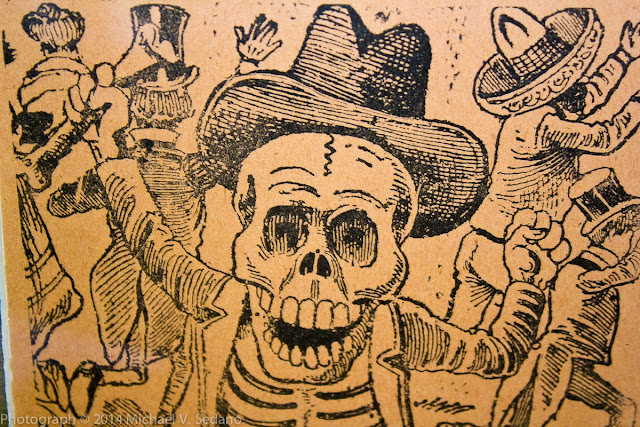 |
| Calaveron detail |
 |
| Calavaititas, size of a nickel coin |
Last Day for L.A. Veterans to Register for Jobs Fair
Today is the final day for Veterans in the Southern California region to enroll to participate in the inaugural "10,000 Strong" Hiring Event. This will be a reverse hiring fair featuring a coalition of partners led from the Mayor's office.
A reverse hiring fair is when pre-screened, veteran applicants attend the 10,000 Strong Hiring Event and are interviewed on site with employers who are currently looking to fill positions for their companies. Pre-screening allows for the best possible match between a veteran and a job opportunity.
Every veteran who enrolls by October 28th will be assigned an employment specialist who will help them prepare for the event future job searches if this event fails to match a Veteran's abilities to an available job.
The 9-5 interviewing event gets rolling November 5th 2014 at Goodwill Industries' Community Enrichment Center at 3150 N San Fernando Rd. Los Angeles, CA 90065.
Veteran Job Seekers must enroll by October 28th to receive assistance with resume and interview preparation. No Veteran will be turned away.
El Sereno DDLM in Fifth Year
That Coachella affair that Margaret Garcia's skull is in looks like a magnificent experience. For gente who cannot make the road trip past Palm Springs, Los Angeles' El Sereno takes a namesake approach to the celebration with a street festival now in its quinto iteration.
Artists, poetry, art, crafts, local businesses like Connie Castro from Hecho En Mexico restaurant will be on hand to greet and welcome locals and travelers from ancient lands.
Giving & Taking
Maximize Your Crowdfunding
It’s such a sound strategy, crowdfunding, that it’s a growth sector of the information industry. Google the term. Anyone with a computer can create a crowdfunding pitch, and a montón of them have.
Using homophily as the basis for asking strangers to give you money is a potent tactic. Who hasn’t received those emails? Lately there's been an upswell supporting an important book that Big Publishing won’t touch, the Latino/a Rising anthology. The editor is soliciting submissions and contributions. If the submissions are worthy, and the money sufficient, the book gets published.
Crowdfunding works. Thousands of people have asked for and gotten millions of dollars from generous publics. Crowdfunding works for the credit card companies, too. Amazon Payments, for example, charges 2.9% plus thirty cents, to collect money for a crowd sourcer. In other words, if you give ten dollars to the project, fifty-nine cents goes into Amazon’s pocket and your causa receives $9.41
Call me a cheapskate. OK, that hurt. But I’m not giving money to Amazon or Paypal or some other card processor. That’s why crowdfunders need to include a mailing address in their pitches. A mailed-in check comes with no hidden processing fees, so when you give that ten dollars, ten dollars goes to the project.
There is a difference. A crowdfund is a pledge, not a donation. If the plea reaches deaf ears, no money goes out of your card to the project. With a check, you've given the money, no-strings attached. The project is at liberty to return your check or not. But then, that's what giving looks like, a one-way money flow.
Mail your check to support Latino/a Rising to: Matthew David Goodwin, 246 Ardmore Ave., Apt. C, Upper Darby, PA 19082
Yodoquinsi in Late-breaking News from Oxnard
Remember this is a unique opportunity to hear prehispanic instrumental group Yodoquinsi.
October 31 2014
5:00 o'clock pm
Downtown Sol
328 W 3rd St , Oxnard , CA 93030
(805) 240-7765
This is the first time that Yodoquinsi has come directly from Mexico. It's a rare opportunity to see and hear a live full range of pre -Columbian instruments.
Thanks to the support and hard work of the Mexican Consulate in Oxnard, Downtown Sol, in coordination with Ollinkalli Cultural Arts Center is able to share this concert with the Ventura County community.
For more information or to reserve your seat contact Downtown Sol or Yenelli Law
SPACE IS LIMITED !
Yenelli Law
Ollinkalli Cultural Arts Center
805 901 6171
Blog: La Bloga (Login to Add to MyJacketFlap)
JacketFlap tags: Add a tag
Blog: La Bloga (Login to Add to MyJacketFlap)
JacketFlap tags: Add a tag
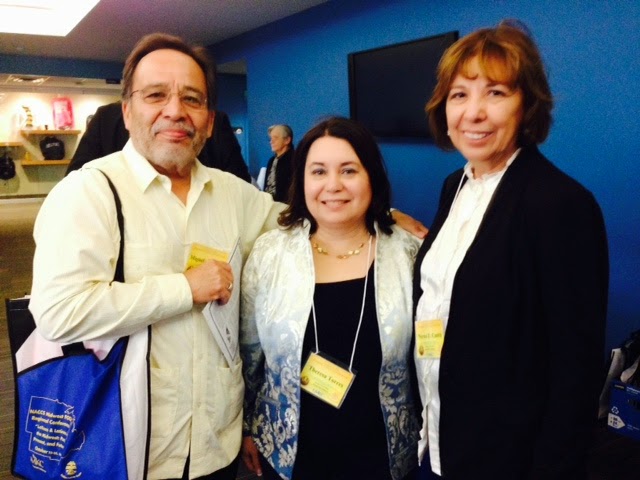 |
| Left to Right: Dr. Miguel Carranza, Director of the Latina/Latino Studies Program; Co-Chair of conference, Theresa L. Torres; Co- Chair of Conference, Norma Cantú |
| Faculty from the new Department of American Ethnic Studies (left to right): Dr. Norma Valenzuela, Dr. Yolanda Broyles-González, Dr. Isabel Millán |
 |
| Dr. Rogelio Sáenz, Dean of the College of Public Policy (University of Texas, San Antonio) |
 |
| Dr. Nancy "Rusty" Barceló |
 |
| From left to right: Poets Minerva Margarita Villarreal, Natalia Treviño, Xánath Caraza |
 |
| Three Generations of Topeka, Kansas Mujeres From left to right: Valerie Mendoza, Graciela Beruman, Christina Valdivia Alcalá |
| From the University of Nebraska-Lincoln: Graduate student, Visjna Vijun, Professor Amelia Montes, Graduate student, Bernice Olivas |
 |
| Left to right: Minerva Margarita Villareal, Dr. Norma Cantú Dr. Cantú reads Minerva's poem in English; |
 |
| Natalia Treviño |
 |
| Xánath Caraza |
View Next 25 Posts





.jpg)


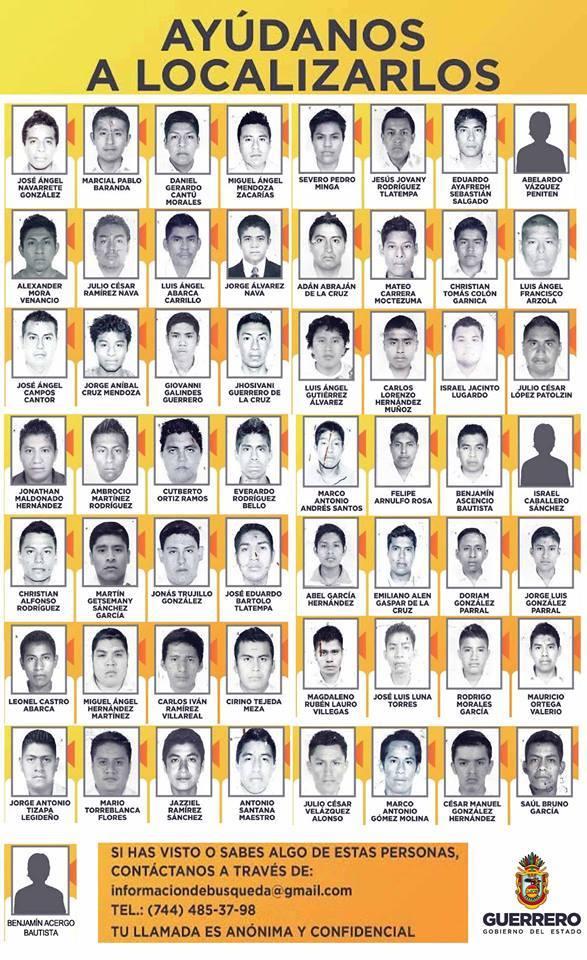
















.jpg)












